Abstract
The deep-sea batfish genus Halieutopsis is reviewed based on worldwide collections. Sixteen species are recognized, including five newly described species: Halieutopsis echinoderma sp. nov. from eastern Taiwan and northeastern Australia, Halieutopsis kawaii sp. nov. from Taiwan and Indonesia, Halieutopsis okamurai sp. nov. from southeastern Japan, Halieutopsis murrayi sp. nov. from the Gulf of Aden, and Halieutopsis taiwanea sp. nov. from northeastern Taiwan. These species differ from their congeners in escal morphology, squamation, and morphometric proportions. Dibranchus nasutus Alcock, 1891, a senior synonym of Halieutopsis vermicularis Smith & Radcliffe, 1912, as well as Dibranchus nudiventer Lloyd, 1909 and Coelophrys oblonga Smith & Radcliffe, 1912, are recognized as valid species in Halieutopsis. Comments on the systematics and biogeographic distributions of the species of Halieutopsis are provided, along with a key to the species.
1. Introduction
The deep-sea batfish genus Halieutopsis, which belongs to the batfish family Ogcocephalidae in the anglerfish order Lophiiformes, was established in 1899 by Garman [1] and currently consists of about 10 nominal species [2,3,4]. They are small (usually less than 100 mm SL), benthic, principally deep-sea fishes that occur at depths of 100–4020 m. Specimens of Halieutopsis are uncommon in collections and only a few taxonomic studies on this genus have been published. Not until the last three decades have more specimens been collected by research vessels and deposited in various institutions around the world, but they have mostly remained poorly sorted and unidentified. In addition, piecemeal sampling in different geographic regions combined with the general paucity of specimens has inevitably meant that some species have been overlooked.
The genus Halieutopsis was established [1] from its type species, Halieutopsis tumifrons Garman [1], also a new species, based on two specimens collected from the Eastern Pacific near the Galápagos Islands. A second species, Halieutopsis vermicularis, was described from the Philippines [5]. In 1962, a revisionary work [6] on the genera of the family Ogcocephalidae reassigned Dibranchus micropus Alcock [7], Dibranchus stellifer Smith & Radcliffe [5], and Dibranchus simulus Smith & Radcliffe [5] to Halieutopsis. After more than two decades, a review work of Halieutopsis was published by Bradbury [8], including four new species, H. andriashevi, H. bathyoreos, H. galatea, and H. ingerorum, which brought the total number of species to nine. A list of the world’s ogcocephalid fishes [2] mentioned that some genera and species, including Halieutopsis spp., needed further study.
Except for the nine species recognized [8], three other species are re-evaluated in the present work. Dibranchus nasutus Alcock [7] was described based on a specimen collected from the Bay of Bengal, eastern Indian Ocean. This name was considered as incertae sedis in Halieutopsis and similar to H. vermicularis based on the form of its frontal bone and escus [2,9]. Its type material was badly damaged, however, and its fragments are now mixed with those of another individual in the same jar (Ref. [10]; pers. obs.). As is explained herein, examination of other specimens in collections around the world has confirmed that D. nasutus is a member of Halieutopsis and also a senior synonym of H. vermicularis. In addition, a photo of Dibranchus nasutus without a description was provided [6], but the specimen could not be located at the USNM and might never been accessioned and catalogued there (pers. obs.).
Dibranchus nudiventer Lloyd [10] was described from the Bay of Bengal, but its validity has been uncertain because the type specimen was lost [9]. Based on the description of the esca, Bradbury [2,10] considered it to be incertae sedis in Halieutopsis and similar to H. vermicularis. However, many specimens collected in the Western Pacific have been shown to be identical with the original description and figure of D. nudiventer [10], so this nominal species is now recognized as valid in Halieutopsis. Because it can be clearly diagnosed based on the original drawing and description and is readily separable from its most closely related congeners, designation of a neotype would not be justified under Article 75 of the International Code of Zoological Nomenclature [11].
Coelophrys oblongus Smith & Radcliffe [5] was described on the basis of a single specimen collected from the Philippines. The only holotype has dried out since then, and many details of, e.g., escal morphology, can no longer be confirmed (pers. obs.); nonetheless, the unreduced pelvic fins and the relatively long tail with 9 or 10 pairs of lateral-line neuromasts indicate that this species is a member of Halieutopsis, not of Coelophrys Brauer [12]. Additional specimens with identical morphology have been collected from the Western Pacific, and a detailed diagnosis based on them is provided herein to clarify the species concept.
In a redescription of H. bathyoreos based on newly collected materials from Japan [13], a number of specimens identified as H. vermicularis were listed for comparison. However, their specimens of H. vermicularis are proved to be a misidentification of H. nudiventer in the present work.
Halieutopsis margaretae Ho & Shao [3], named after M. G. Bradbury, was described on the basis of the type series collected from the western and central North Pacific Ocean. In the documentary of ogcocephalids found in Taiwan [4], two species, H. ingerorum Bradbury [4] and H. simula (Smith & Radcliffe [5]), were reported for the first time in Taiwan, and Dibranchus micropus was reassigned to Coelophrys, a decision that is accepted here because of the extremely reduced pelvic fins in that species and a combination of other features [4,6,14]. However, their H. ingerorum is now recognized as a new species and is being described as Halieutopsis taiwanea in the present work.
After Bradbury’s [8] review of Halieutopsis was published, she continued to work on this group and examined many specimens deposited in Russian, French, Japanese, and South African collections (pers. obse.). Large quantities of photographs and data were transferred to the present author in 2006 and 2008 when the two met at Pacific Grove, Monterey, California, a few years before her death [15].
Since then, the present author has examined most of the specimens of this genus in world collections, including those previously examined by Bradbury. The purposes of the study are to (1) review all previously known species of Halieutopsis and provide diagnostic characters and new morphological and distributional data for each of them, (2) name and describe any new undescribed species of this genus, (3) provide a key to the species of Halieutopsis, and (4) comment on the systematics of species and their biogeography.
As a result of this work, 16 species are now recognized in Halieutopsis including five new species described herein, a second specimen of H. andriashevi is reported from the Indian Ocean, and the known distribution ranges of most other species have been broadly extended.
2. Materials and Methods
Standard length (SL) expressed in millimeters is used throughout. The terminology, methods and definitions of characters used in this study follow Bradbury [6,8] and Ho and Shao [3]. Proportional measurements are calculated from actual measurements rounded to the nearest 0.1 mm. The number of specimens and range of SL are provided in parentheses after their catalogue numbers in the materials.
Morphometrics are defined as follows: Standard length (SL), from symphysis of upper jaws to end of hypural plate (caudal-fin base); head length (HL), from symphysis of upper jaws to groove between skull and first vertebra; head width, distance between both contralateral joints of opercle and pterotic; head depth, distance between second neuromast of dorsolateral branch of subopercular lateral line and joint of opercle and pterotic; orbital diameter, greatest diameter of bony orbit; interorbital width, narrowest distance between lateral margins of frontal bones; mouth width, greatest overall width; upper-jaw length, distance from center of upper jaws to posterior end of maxilla; illicial cavity width, broadest width of illicial cavity opening; predorsal length, distance from symphysis of upper jaws to dorsal-fin origin; pre-anus length, distance from symphysial spine of lower jaws to genital papilla (situated immediately posterior to anus); preanal length, distance from symphysial spine of lower jaws to origin of anal fin; disk-margin length, measured on ventral side as distance from posterior swelling of mandible to posterior base of subopercular buckler; pectoral-fin length, distance from base to distalmost tip of longest fin ray; anal-fin length, distance from origin of anal fin to distalmost tip of longest fin ray; dorsal-fin length, distance from origin of dorsal fin to distalmost tip of longest fin ray; caudal-fin length, distance from base of caudal fin to distalmost tip.
Line drawings in figures showing the morphological details may not be to scale but were generally in a similar ratio. Credits or authors of color photographs in figures were given, except for those taken by the author.
Lateral-line neuromast counts follow Bradbury [8], including a supraorbital series (SS), premaxillary series (PMS), cheek series (CS), body series (BS), preopercular series (POS), subopercular series (SOS), dorsolateral branch of subopercular series (DBSS), posterior branch of subopercular series (PBSS), ventral series (VS), and tail series (TS).
Institutional abbreviations are listed as follows: AMS: Australian Museum, Sydney, Australia. ASIZP: Academia Sinica, Taipei, Taiwan. BPBM: Bernice P. Bishop Museum, Honolulu, USA. BSKU: Kochi University, Kochi, Japan. CAS: California Academy of Sciences, San Francisco, USA. CSIRO: Commonwealth Science & Industrial Research Organization, Hobart, Australia. FRIP: Fishery Research Institute, Keelung, Taiwan. HUMZ: The Fisheries Science Center, The Hokkaido University Museum, Hakodate, Japan. MCZ: Museum of Comparative Zoology, Harvard University, Cambridge, USA. MNHN: Muséum national d’Histoire naturelle, Paris, France. NMMB-P: Pisces collection, National Museum of Marine Biology & Aquarium, Pingtung, Taiwan. NMNZ: National Museum of New Zealand Te Papa Tongarewa, Wellington, New Zealand. NMV: National Museum of Victoria, Melbourne, Australia. NSMT-P: National Museum of Nature and Science, Tsukuba, Japan. NTM: Northern Territory Museum of Arts & Sciences, Darwin, Australia. QM: Queensland Museum, Brisbane, Australia. SIO: Scripps Institution of Oceanography, La Jolla, USA. USNM: Museum Support Center, National Museum of Natural History, Smithsonian Institution, Suitland, USA. WAM: Western Australian Museum, Perth, Australia. ZMA: Universiteit van Amsterdam, Zoologisch Museum, Amsterdam, The Netherlands (now at Naturals Biodiversity Center, Leiden). ZMMU: Zoological Museum, Moscow State University, Moscow, Russia. ZMUC: Zoological Museum, University of Copenhagen, Copenhagen, Denmark. ZSI: Zoological Survey of India, Kolkata, India.
3. Results
3.1. Family Ogcocephalidae
3.1.1. Halieutopsis Garman, 1899
Halieutopsis Garman [1]: 89. (Type species Halieutopsis tumifrons Garman, 1899, by original designation). Bradbury [6]: 411 (review of genera); Bradbury [8]: 2 (review); Bradbury [2]: 7 (checklist). Ho & Shao [3]: 87 (mentioned).
Diagnosis. Gill filaments absent from first and fourth gill arches; teeth usually present on fifth ceratobranchial, in two small and well-separated patches. Illicial bone relatively simple and spine-like, lacking foramina in base; esca usually bearing two large lateral lobes (except for H. simula), and a dorsal median lobe usually provided with cirri or skin flaps. Pectoral pedicels broadly attached to body wall. Lateral line interrupted, with tail series running ventrally and extending anteriorly to or beyond anus, 1–6 neuromasts on either side of anus (ventral series).
Description. Dorsal-fin rays 4–7, mostly 5 or 6. Pectoral-fin rays 13–17, mostly 14–16 (Table 1). Pelvic-fin rays 5. Anal-fin rays 3 or 4, usually 4. Caudal-fin rays 9. Head and body strongly depressed; disk broad, rounded to subtriangular, about as wide as long; tail slender, somewhat cylindrical, tapering posteriorly. Rostrum a bony shelf, slightly elevated anteriorly and well overhanging or overlaying mouth; tubercle on rostrum simple or trifid, directed upward and forwards. Illicial cavity is deeply concave, its opening differing among species in size and outline; pair of olfactory sacs flanking illicial cavity. Esca housed in illicial cavity, divided into three lobes: Pair of rounded and well-separated ventral lobes, and leaf- or tongue-like dorsal median lobe with cirri on tip and 0–3 pairs of small, lateral appendages.

Table 1.
Frequency of dorsal- and anal- fin rays in all Halieutopsis species in present study. Pectoral-fin rays were counted on both sides. * denotes value of holotype.
Eyes small, oval, directed laterally and upwards. Mouth moderate, slightly concave; upper jaw slightly overhanging lower jaw, a shallow concavity between midline between premaxillae present or not. Narrow bands of villiform teeth present on jaws, visible on upper jaw when mouth fully closed; no teeth on palatines and vomer. Tooth plates bearing minute teeth present on second and third pharyngobranchials; two small and well-separated tooth patches present on fifth ceratobranchial (tongue).
Gill openings on dorsal surface between pectoral fin lobes and body wall. Holobranchs present on second and third gill arches, gill filaments absent on first and fourth arches. First to third arches bearing 6–8 pairs of finger-like gill rakers with clusters of minute teeth, fourth arch lacking gill rakers.
Pectoral fin lobe broadly, but not fully, attached to body wall; pectoral fins large, at rear of lateral part of disk, directed outwards, with fin lobes broadly but not fully attached to body wall. Pelvic fins small and slender, on ventral surface and closer to mouth than to anus. Dorsal and anal fins small of about equal size. Caudal fin about equal in length to pectoral fin.
Tubercles present on dorsal surface only or on entire body, in either case absent from gill openings, eye membranes, illicial cavity, and fins. Small spinules sometimes present between principal tubercles. Principal tubercles on dorsal surface needle-like with broad base, their bases usually with 4–8 facets (some up to 14); those on disk margin usually simple or bifurcate distally, but sometimes fused to form serrated margins; those on tail simple or bifurcate, sometimes trifid; that on subopercle divided into 2–7 short spinelets, depending on species and growth stage.
Lateral-line scales new-moon like, with neuromasts lined up around head, body, and tail and underside along disk margins. Counts of lateral-line neuromasts: SS 3–9, PMS 0–1, CS 7–9, BS 8–14, POS 2–5, SOS 5–7 (mostly 6), DBSS 1–5, PBSS 3, vs. 1–6, TS 7–15 (Table 2).

Table 2.
Frequency of selected lateral-line neuromasts in all Halieutopsis species in present study. Most values are counted on both sides when available. * denotes value of holotype. DBS = Dorsal branch of subopercular.
Distribution. Inhabiting continental shelves, continental slopes, and deeper waters of temperate to tropical zones in Indo-Pacific region at depth ranging from about 100 m to 4020 m.
Diversity. Currently 16 species are recognized in Halieutopsis, including five species newly described in the present work and three others newly transferred from other genera: Halieutopsis andriashevi Bradbury, 1988; H. bathyoreos Bradbury, 1988; H. echinoderma Ho, sp. nov.; H. galatea Bradbury, 1988; H. kawaii Ho, sp. nov.; H. ingerorum Bradbury, 1988; H. margaretae Ho & Shao, 2007; H. murrayi Ho, sp. nov.; H. nasuta (Alcock, 1891) (new combination; syn. Halieutopsis vermicularis Smith & Radcliffe, 1912); H. nudiventer (Lloyd, 1909) (new combination); H. oblonga Smith & Radcliffe, 1912 (new combination); H. okamurai Ho, sp. nov.; H. simula (Smith & Radcliffe, 1912) (syn. Dibranchus infranudus de Beaufort in Weber & de Beaufort, 1962); H. stellifera (Smith & Radcliffe, 1912); H. taiwanea Ho, sp. nov.; and H. tumifrons Garman, 1899.
Remarks. Many members of Halieutopsis were previously classified in Coelophrys or Dibranchus prior to Bradbury’s [9] review of the genus. Halieutopsis differs from Coelophrys in having normal-sized pelvic fins for the family (vs. greatly reduced in Coelophrys); a generally flat body disk (vs. mostly box-like, or at least with a box-like head); the illicium and esca free from the illicial cavity (vs. connected by membranes to the wall of the illicial cavity); a generally long tail (vs. extremely short to moderately long), although small individuals may have a very short tail; and narrow and strong (vs. flat and weak) frontal bones.
Halieutopsis differs from Dibranchus in having the pectoral-fin bases (or pectoral elbows) not well-connected to the body wall (vs. well-connected in Dibranchus); an esca usually with two rounded, bulb-like lower lobes and a tongue-like dorsal lobe with some lateral flaps and terminal cirri (vs. a sub-triangular esca, not divided into rounded lobs, with two terminal cirri on the dorsal tip); two small, well-separated patches of teeth on the tongue (vs. two long and large patches with their posterior parts nearly adjoining); and the ventral lateral line series with 1–6 neuromasts on each side of the anus, the first one always being situated before the anus (vs. only 1 neuromast on each side, which is clearly behind the anus).
3.1.2. Key to Species of Halieutopsis
1A. Mouth upturned; entire rostrum posterior to month ………………….………………….2
1B. Mouth terminal or ventral; rostrum overlaying or overhanging mouth… …..……3
2A. Head and body disk relatively large (head length 26.8–27.6% SL, disk margin 43.4–44.0% SL), reflecting by the larger body proportions and a shorter tail (tail length 41.9–43.9% SL) …………………….……………………..H. ingerorum (Western Indian Ocean)
2B. Head and body disk relatively small (head length 22.6–22.8% SL, disk margin 35.6–38.1% SL), reflecting by the smaller body proportions and longer tail (tail length 44.6–50.1% SL) ……..……………………………………….………..H. taiwanea sp. nov. (Taiwan)
3A. Disk small (disk margin 34.4–38.2% SL); tubercles at edges of disk forming saw-toothed ridges ……..………………………………………………..H. andriashevi (Indian Ocean)
3B. Disk large, its margin >38% SL (mostly >40% SL); no saw-toothed ridges formed by tubercles along disk margins …………………..………………….…………….…………….4
4A. Esca covered with mass of filaments…………..…….….…..…H. simula (Western Pacific)
4B. Esca with two rounded ventral lobes and leaf-like dorsal lobe ………………………….5
5A. Tubercles associated with lateral-line neuromasts on tail bifurcate or trifid ……..……6
5B. Tubercles associated with lateral-line neuromasts on tail simple ……………..…………9
6A. Anterior margin of disk truncate or slightly concave, not pointed; ventral surface naked, except for few tubercles on pelvic-fin bases) ……………….…………..…………7
6B. Anterior margin of disk pointed or with a broad rostrum extending well beyond mouth; ventral surface covered with tubercles ………………………………….………….8
7A. Anterior margin of disk slightly concave; rostrum not extending anteriorly beyond disk margin ……………………..……………………..H. tumifrons (near Cocos Is., Eastern Pacific)
7B. Anterior margin of disk slightly bulging; rostrum extending anteriorly beyond disk margin slightly…..…………………………………………..H. okamurai sp. nov. (southern Japan)
8A. Ventral surface densely spaced and bifurcate tubercles; dorsal surface uniformly gray or dark blue……………….………………………….H. margaretae (Hawaii and Western Pacific)
8B. Tubercles on ventral surface rather apart with variable spacing, sometimes absent from belly, never bifurcate; dorsal surface with dark vermicular pattern ………H. nasuta (Indo-West Pacific)
9A. Ventral surface of disk completely naked or only few tubercles present at pelvic fin bases………………………….……………………………….…………………………………10
9B. Ventral surface of disk densely covered with many tubercles………………………….11
10A. Rostrum a broad, shelf-like plate, extending well in front of mouth; illicial cavity opening downwards, entirely visible in ventral view; principal tubercles rather densely arranged on dorsal disk surface, each with 6–8 facets …H. bathyoreos (Indo-West Pacific)
10B. Rostrum a small triangle, not extending much beyond mouth; illicial cavity opening forwards, half or less of it visible in ventral view; principal tubercles more sparsely scattered on dorsal surface, each with 10–14 facets ….H. nudiventer (Indo-West Pacific)
11A. Head more or less box-like; body flabby; interorbital space very wide (15.6–19.5% SL); subopercular spines rather weak, not especially developed…………H. stellifera (Indo-West Pacific)
11B. Head strongly depressed; body firm; interorbital space generally narrow (<16.2% SL, mostly <14% SL); subopercular spine well developed……………….……………………12
12A. Body uniformly black; tubercles on disk margin rather elongated; subopercular tubercle elongated with 4 spinelets forming two forks ………………..…H. murrayi sp. nov. (Gulf of Aden)
12B. Body gray to deep brown; tubercles on disk margin generally stout; subopercular normal, not especially elongated and not forming fork as above……………….…….…13
13A. Pale reticulate pattern on dorsal surface associated with principal tubercles ………14
13B. Body uniformly deep brown without such patterning…………………………….…..15
14A. Disk remarkably rounded with blunt rostrum; illicial cavity forming deep notch in anterior view; interorbital space narrow (11.7–12.4% SL) …………………………H. galatea (Indian Ocean: Mozambique to NW Australia)
14B. Disk subtriangular with triangular rostrum; illicial cavity not forming notch in anterior view; interorbital space wide (13.5–16.2% SL) …………………H. echinoderma sp. nov. (Western Pacific: Taiwan and Queensland)
15A. Tubercles on rostrum and anterior margin of head forked or trifid; ventral surface densely covered with tubercles; interorbital broad (11.4–13.8% SL) ……………H. oblonga (Indo-West Pacific)
15B. Tubercles on rostrum and anterior margin of head simple; ventral surface sparsely covered with tubercles; interorbital narrow (9.9–11.3% SL) ………….…H. kawaii sp. nov. (Taiwan and Indonesia)
3.1.3. Halieutopsis andriashevi Bradbury, 1988
(Andriashev’s deepsea batfish)
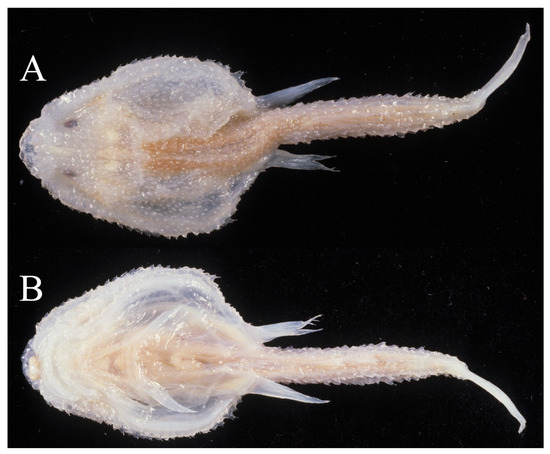
Figure 1.
Halieutopsis andriashevi Bradbury, 1988, holotype, SIO 61-14-65A, 46.2 mm SL, Indian Ocean. (A). Dorsal view. (B). Ventral view. Photos by M. G. Bradbury.

Figure 2.
Esca and squamation of H. andriashevi Bradbury, 1988, from BSKU 23697, 51.0 mm SL. (A). Rostral tubercles. (B). Esca. (C). Tubercles on disk margin. (D). Tubercles on tail. (E). Subopercular tubercle.

Figure 3.
Distribution map of eight Halieutopsis species. 1. H. andriashevi; 2. H. echinoderma sp. nov.; 3. H. galatea; 4. H. ingerorum; 5. H. kawaii sp. nov.; 6. H. murrayi sp. nov.; 7. H. oblonga; 8. H. okamurai sp. nov. One dot may represent more than one capture.

Table 3.
Morphometric and meristic data of H. andriashevi, H. bathyoreos and H. galatea.* Data taken from Bradbury (1988). DBS = Dorsal branch of subopercular. HT = holotype. NT = Nontype(s).
Synonymy. Halieutopsis andriashevi Bradbury [8]: 16 (holotype: SIO 61-14-65A; type locality: Indian Ocean at 19°09′ S, 63°07.5′ E). Bradbury [2]: 7 (checklist).
Specimens examined. Holotype (Figure 1 and Figure 2). SIO 61-14-65A (female, 46.2), 19°09′ S, 63°07.5′ E, central western Indian Ocean, 3800–4000 m. Non-type. BSKU 23697 (1, 51.1), 4°59.9′ N, 86°57.7′ E–5°00.3′ N, 86°55.0′ E, northeastern Indian Ocean, 3 m beam trawl, 4020 m, 7 February 1977.
Diagnosis. Dorsal-fin rays 4–5; pectoral-fin rays 14–15. Disk small and tail long. Esca small, its dorsal lobe with tongue-like structure and thin posterior flap (Figure 2B). Tubercles on edges of disk and lateral sides of tail low and closely adjoining, forming thin, continuous, saw-toothed ridges; subopercular tubercle poorly developed, with two short spinelets (Figure 2C–E). Proportional measurements relatively small compared to other species: eye diameter 24.9–27.0% SL; disk margin 34.4–38.2% SL; head width 17.3–22.7% SL; dorsal-fin length 14.5–15.1% SL; pectoral-fin length 18.0–20.4% SL; anal-fin length 14.1–15.1% SL; caudal-fin length 24.2–24.7% SL (Table 3). Lateral-line neuromasts: SS 3–6, POS 2–3, SOS 5, DBSS 3, vs. 1–3, TS 8–11 (Table 1 and Table 2). Preserved coloration light brown to creamy white, somewhat translucent with thin skin.
Distribution. Only known from two specimens collected from central western and northeastern Indian Ocean at depths of 3800–4020 m (Figure 3).
Remarks. Bradbury [8] mentioned no lateral-line scales on the dorsal surface of the holotype, but the new specimen from the northeastern Indian Ocean has lateral-line neuromasts there as in other congeners. Collected at 4020 m, the latter specimen represents the deepest known record for the genus as well as the family.
3.1.4. Halieutopsis bathyoreos Bradbury, 1988
(Broad-snout deepsea batfish)
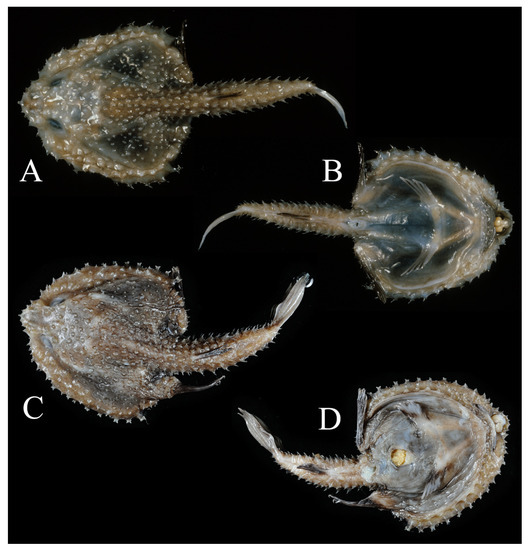
Figure 4.
Halieutopsis bathyoreos Bradbury, 1988. (A,B). Holotype, SIO 84-43, 62.6 mm SL, Pacific Ocean, photos by M. G. Bradbury. (C,D). NSMT-P66375, 67.7 mm SL, Okinawa trough, photos courtesy of NSMT. (A,C). Dorsal view. (B,D). Ventral view.
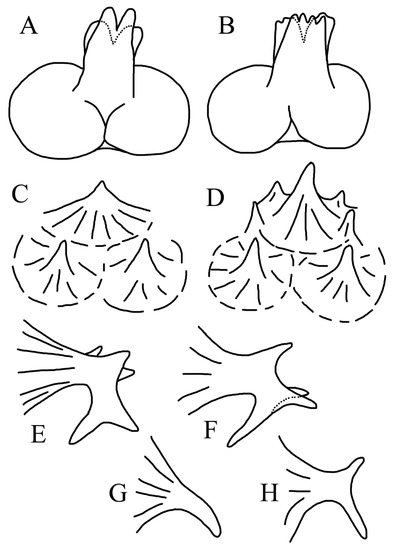
Figure 5.
Esca and squamation of H. bathyoreos Bradbury, 1988. (A,B). Esca. (C,D). Rostrum. (E,F). Subopercular tubercles. (G). Tubercle on tail. (H). Tubercle on disk margin. (A,C,E,G). From AMS I.27038-001, 28.8 mm SL. (B,D,F,G). From AMS I.30738-001, 57.2 mm SL.
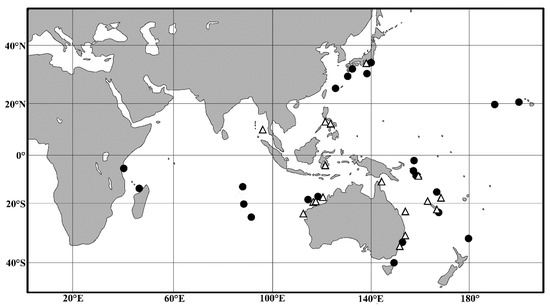
Figure 6.
Distribution map of H. bathyoeros (black dots) and H. nasuta (open triangles). One dot may represent more than one capture.
Synonymy. Halieutopsis bathyoreos Bradbury [8]: 18 (holotype: SIO 84-43; type locality: central North Pacific). Bradbury [16]: 2025 (list, western central Pacific). Bradbury in Randall & Lim [17]: 598 (checklist). Bradbury [2]: 7 (checklist). Shimazaki et al. [14]: 120 (redescription). Ho et al. [18]: 198 (New Zealand). Ho [19]: 899 (New Zealand).
Dibranchus nudiventer (non Lloyd [10]): Norman [20]: 113 (Zanzibar; misidentified).
Dibranchus nasutus (non Alcock [7]): Brauer [21]: 328 (possible misidentification, based on literature description; specimen not examined).
Halieutopsis vermicularis (non Smith & Radcliffe [5]): Bradbury [8]: 15 (in part, larva).
Specimens examined. Holotype (Figure 4). SIO 84-43 (62.6), R/V New Horizon, 19°14.3′ N, 169°07.3′ W, central North Pacific, 1500 m, 25 June 1983. Non-types. Hawaii: BPBM 40452 (ex. BPBM 38952, 1, 32.0), north of Maui, Hawaii, shrimp trawl, [?100]–800 m, 16 July 1972 (collected with paratype of H. margaretae). Japan: BSKU 18859 (1, female, 68.6), 34°04.2′ N, 140°00.5′ E, off Miyake Island, Tokyo, 1180 m, 9 September 1957; BSKU 19518 (1, female, 52.4), 29°17.0′ N, 130°13.3′ E, off the Amami Islands, Kagoshima (Ryuhyu Is.), 1130 m, 8 February 1964; BSKU 86825 (1, 42.3), 32°24.2′ N, 132°16.0′ E, Hyuga Basin, Miyazaki, Kyushu, 1501–1516 m, 16 December 1999; BSKU 86834 (1, female, 42.1), 32°18.2′ N, 132°21.6′ E, Hyuga Basin, Miyazaki, Kyushu, 1678–1690 m, 16 December 1999; BSKU 86871 (1, 46.1), 32°31′ N, 132°13′ E, Hyuga Basin, Miyazaki, Kyushu, 997–1030 m, 16 December 1999; SIO 70-308 (1, juvenile, 25.6), R/V Melville, 29°58.8′ N, 137°11.5′ E, Okinawa Trough, Isaacs-Kidd midwater trawl (IKMT), 0–1350 m, 30 August 1970; NMST-P 66375 (1, 67.7), 26°14.6′ N, 125°16.4′ E, Okinawa Trough, 961–991 m, 26 April 2002 (Figure 4). Eastern Australia: AMS I.27038-001 (2, 30.6–57.5), 32°56′ S, 151°50′ E, off Newcastle, New South Wales, 1040–1075 m, 9 October 1982 (Figure 5); AMS I.30738-001 (1, 57.5), 32°52′ S, 152°48′ E, 80 km E of Newcastle Bight, New South Wales, 1040–1076 m, 14 June 1989; CSIRO H 5312-03 (1, 73.8), 39°52′ S, 148°59′ E, east of Flinders Island, Tasmania, 2000. Western Australia: NMV A29677-009 (1, 18.0), 16°38.04′ S, 119°9.24′ E, Northwest Shelf, 987–990 m, 17 June 2007; NMV A29678-008 (1, 22.6), 16°38′41″ S, 119°08′11″ E, 991–998 m, 17 June 2007; ZMMU P15818 (3, 46.4–60.6), Northwest Shelf, 16°55′ S, 114°53′ E, 1600–1700 m, Northwest Shelf, 24 April 1979. New Zealand: NMNZ 17314 (1, 28.0), 30°11.5′ S, 179°52.0′ E, 960–1205 m, Isaacs-Kidd midwater trawl (hit bottom), 26 July 1962. Papua New Guinea: BSKU 53306 (1, female, 57.7), 02° S, 157° E, 4 January 1968. New Caledonia: MNHN 2000-0334 (2, 28.3–44.6), biocal, n.o. jean, sta. cp60, 24°1′1.2″ S, 167°7′58.8″ E, Coral Sea, 1480–1530 m, 2 September 1985; MNHN 2000-0338 (1, 49.0), biocal, n.o. jean-charcot, sta. cp69, 23°52′1.2″ S, 167°58′1.2″ E, Coral Sea, 1220–1225 m, 3 September 1985. Vanuatu: MNHN 2006-1318 (1), n.o. jean, sta. cp69, 15°58′0″ S, 166°40′0″ E, Coral Sea, 1210–1260 m, 10 October 1994. Solomon Islands: MNHN 2006-1464 (1, 39.6), salomon 2, n.o. alis, sta. 2232, 6°25′8.4″ S, 156°23′2.4″ E, Choiseul Island, 1045–1207 m, 29 October 2004; MNHN 2006-0273 (1, 40.6), salomon 2, n.o. alis, sta. 2272, 8°32′13.2″ S, 157°44′14.4″ E, [?380–537] m, 5 November 2004. Tanzania: BMNH 1939.5.24.1915 (1, 48.9), John Murray Expedition, Zanzibar, 1760 m, 1933–1934. Madagascar: MNHN 1988-1572 (1, 49.0), n.o. vauban, sta. ch138, 13°48′7.2″ S, 47°29′2.4″ E, 1800–2000 m, 27 February 1975. Indian Ocean: ZMMU P15808 (2, 65.5–73.1), 19°45′ S, 87°54′ E, southwest of Cocos (Keeling) Islands, 1560–1650 m, 22 March 1979; ZMMU P15820 (1, 72.6), 11°31′ S, 88°55′ E, southwest of Cocos (Keeling) Islands, 1600–1700 m, 18 February 1979; ZMMU P15810 (3 of 4, 37.8–61.6), 14°51′ S, 86°49′ E, 1760 m, 19 March 1979.
Diagnosis. Rostrum very broad and shelf-like, extending almost completely anterior to mouth. Illicial cavity very wide (9.3–13.3% SL, mean 11.0%), with its opening directed downward and esca completely visible in ventral view. Tubercles on dorsal surface relatively small and dense, each with 6–8 facets; ventral surface smooth, with only a few (usually 2) flat tubercles at pelvic-fin bases and occasionally a few around anus. Following proportional measurements relatively small compared to other congeners: skull length 24.2–29.5% SL, head depth 22.2–29.4% SL, eye diameter 6.7–10.0% SL, predorsal length 58.0–68.3% SL, preanal length 65.5–74.0% SL, dorsal-fin length 12.5–18.8% SL (Table 3). Lateral-line neuromasts: SS 4–6 (mainly 5), POS 2–3 (2), SOS 5–6 (5), DBSS 2–3 (3), vs. 1–3 (2 or 3), TS 10–13 (10–11) (Table 1 and Table 2).
Comparison. Halieutopsis bathyoreos is similar to those species that lack ventral tubercles aside from a few on the pelvic fin base and occasionally around the anus. It is most similar to H. nudiventer (new combination) but can be separated by its broad, shelf-like rostrum that extends well anterior to the mouth (vs. relatively narrow and not extending much beyond the mouth in H. nudiventer) and a combination of other features, for which see the description and comparative remarks for H. nudiventer below.
Halieutopsis bathyoreos is also similar to H. nasuta (see below) but differs in having simple tubercles on the lateral sides of the tail (vs. bifurcate tubercles), no vermiculate pattern on the dorsal surface, and only a single pair of appendages on the dorsal lobe of esca (vs. 1–2 additional small lateral pairs present); and most of its proportional measurements are smaller than those of H. nasuta (see below).
Distribution. Widespread in the Indo-West Pacific off Madagascar, Tanzania, Papua New Guinea, New Caledonia, Vanuatu, Solomon Islands, Australia, New Zealand, and Japan, and in the central North Pacific off Hawaii (Figure 6). Bathymetric range ca. 800 m to 2000 m, mostly deeper than 1000 m.
Remarks. A small juvenile (SIO 70-308) identified as H. vermicularis by Bradbury [8] and another specimen (BMNH 1939.5.24.1915) identified as Dibranchus nudiventer by Norman [20] are both reidentified here as H. bathyoreos.
A specimen (MNHN 2006-0273) was collected from Solomon Islands at 380–537 m deep, and another specimen was collected from Hawaii at a depth of 100–800 m; both are clearly shallower than all other records and are thus doubtful. The majority of specimens were collected from deeper than 1000 m.
3.1.5. Halieutopsis echinoderma sp. nov.
(Spiny deepsea batfish)
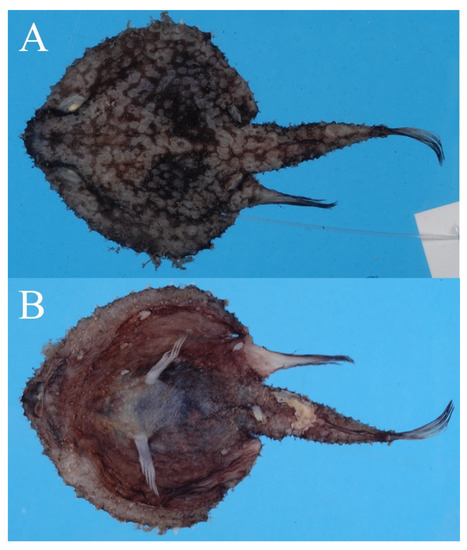
Figure 7.
Halieutopsis echinoderma sp. nov., Holotype, ASIZP 62587, 60.2 mm SL, northeastern Taiwan, fresh. (A). Dorsal view. (B). Ventral view.
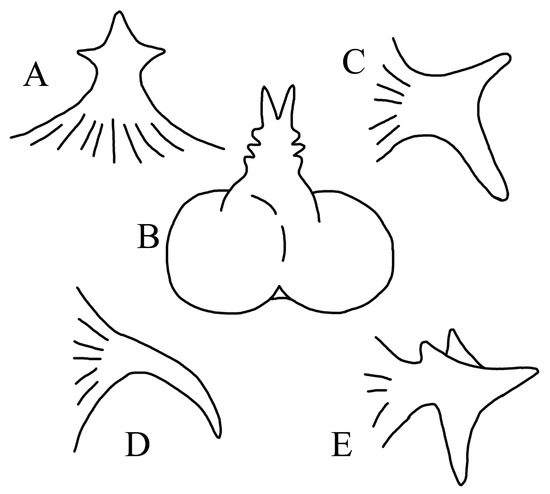
Figure 8.
Esca and squamation of H. echinoderma sp. nov., from holotype. (A). Rostral tubercle. (B). Esca. (C). Tubercle on disk margin. (D). Tubercle on tail. (E). Subopercular tubercle.

Table 4.
Morphometric and meristic data of H. echinoderma sp. nov.
Zoobank: urn:lsid:zoobank.org:act:50F8509D-5200-4223-A476-4D04A3237385
Type series. Holotype (Figure 7 and Figure 8). ASIZP 62587 (female, 60.2), Daxi, Yilan, northeastern Taiwan, northwestern Pacific, bottom trawl, ca. 400 m, 1 September 2002, coll. H.-C. Ho. Paratypes. QM I.21017 (2, 54.0–66.1), FRV Iron Summer, 28°03′ S, 153°58′ E, east of Gold Coast, Queensland, Australia, bottom trawl, 480 m, 8 September 1982; QM I.20671 (1, 45.0), 9°51′ S, 144°09′ E, east of Murray Is., Queensland, Australia, bottom trawl, 464 m, 27 May 1983; CSIRO H 832-03 (2, 69.4–74.0), 20°23′ S, 152°57′ E, south of Marion Reef, Marion Plateau, Queensland, Australia, 508 m, 22 November 1985; CSIRO H 644-08 (1, 54.7), 22°46′ S, 154°08′ E, Saumarez Reef, Queensland, Australia, lobster trawl, 445–450 m, 17 November 1985.
Etymology. The species name echinoderma, a noun in apposition from the Greek εχινόδερμα, means “spiny skin” in referring to the squamation.
Diagnosis. Vermiculate color pattern on dorsal surface. Numerous small tubercles interspersed among principal tubercles on dorsal surface; principal tubercle on rostrum trifid (Figure 8A); principal tubercles on tail simple, never bifurcate (Figure 8D). Dorsal lobe of esca bearing one pair of cirri on tip and two or three lateral pairs of small flaps (Figure 8B). Following proportional sizes relatively large compared to other congeners: Skull length 31.1–34.1% SL, head depth 25.7–32.4% SL; interorbital width 13.5–16.2% SL, disk margin 43.5–49.4% SL; 3–5 (mainly 3) lateral-line neuromasts in ventral series.
Description. Proportional measurements of specimens in type series as given in Table 4, meristics in Table 1, Table 2 and Table 4.
Dorsal-fin rays 5 (4–5), pectoral-fin rays 16 (16–17). Body disk depressed, about as wide as long; disk relatively long and broad as reflected in proportions of head depth and disk margin length. Rostrum consisting of three enlarged tubercles, with principal tubercle trifid, directed forwards and upwards (Figure 8A). Illicial cavity as wide as high, visible in ventral view. Dorsal lobe of esca leaf-like, with two small cirri on the tip and usually three (2–3) lateral pairs of small flaps (Figure 8B). Interorbital space relatively wide (13.5–16.2% SL) compared to other congeners.
Principal tubercles on dorsal surface needle-like, mostly with 5–6 facets, those on disk margin bifurcate (Figure 8C), those on tail and ventral body surface simple and never bifurcate (Figure 8D), and those on subopercle divided into 4 short spines (Figure 8E). Lateral-line neuromasts: SS 5–6, PMS 0, CS 8–9, BS 8–9, POS 3, SOS 5–7 (mainly 6), DBSS 3, PBSS 3, vs. 3–5 (mainly 3), TS 8–11 (Table 1 and Table 2).
Coloration. When fresh (Figure 7A,B), ground color of body black, with irregular white patches on skull, together with other such patches associated with principal tubercles on dorsal surface and tail, forming somewhat vermiculate pattern. Ventral surface paler at pelvic fin bases and on belly, darker on chin and outside of gill chambers, pale around anus. All fins darker than ground color, except for paler undersides of pectoral fins. When preserved, holotype uniformly blackish with large, pale tubercles forming somewhat reticulate pattern; paratypes rather creamy white.
Distribution. Represented by type series collected from Western Pacific off northeastern Taiwan and in Coral Sea off Queensland, Australia (Figure 3). Bathymetric range ca.400 m to 511 m.
Comparison. Halieutopsis echinodema is most similar to H. galatea (see below) in having small spines between the principal tubercles and a relatively depressed disk, but differs in having a subtriangular disk with a pointed rostrum (vs. rounded with a blunt rostrum), a broader interorbital space (13.5–16.2% SL, vs. 11.7–12.4), a relatively long pre-anus length (63.1–68.9% SL, vs. 57.4–64.5), and a relatively short tail (31.1–36.9% SL, vs. 35.5–42.6%).
The vermiculate pattern on the dorsal surface is similar to that of H. nasuta (see below). Both species also always have tubercles on the ventral surface, but contrary to H. echinoderma, in H. nasuta they are quite sparse centrally. The rostrum, the principal tubercles on the disk margin and dorsal surface, and the lateral-line neuromast counts are all similar between these two species, but in H. echinoderma, the principal tubercles on the lateral sides of the tail are simple (vs. bifurcate), small spines are present between the principal tubercles (vs. absent) and the interorbital space is wider (13.5–16.2% SL, vs. 10.3–13.3% SL).
3.1.6. Halieutopsis galatea Bradbury, 1988
(Galathea deepsea batfish)
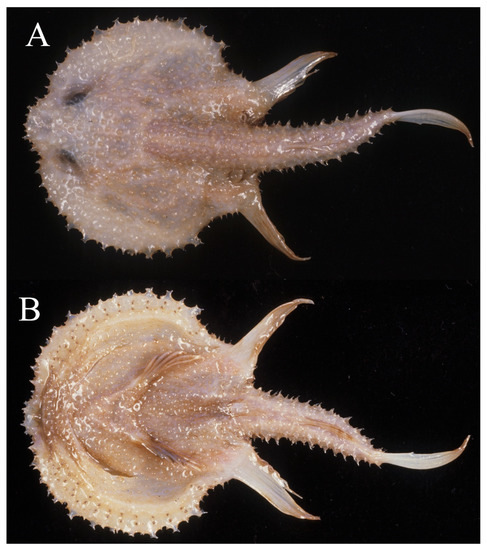
Figure 9.
Halieutopsis galatea Bradbury, 1988, holotype, ZMUC 922207, 55.1 mm SL, Western Indian Ocean, photos by M. G. Bradbury. (A). Dorsal view. (B). Ventral view.

Figure 10.
Esca and squamation of H. galatea Bradbury, 1988, from ZMMU P15825, 70.4 mm SL, Indian Ocean. (A). Rostral tubercle. (B). Esca. (C). Tubercle on disk margin. (D). Tubercle on tail. (E). Subopercular tubercle.
Synonymy. Halieutopsis galatea Bradbury [8]: 18 (holotype: ZMUC P922207, off Kenya, western Indian Ocean). Bradbury [2]: 7 (checklist). Ho & Shao [3]: 90 (mentioned).
Specimens examined. Holotype (Figure 9). ZMUC P922207 (55.1), Galathea expedition, sta. 241, 4°00′ S, 41°27′ E, off Kenya, western Indian Ocean, 1551 m, 15 March 1951.
Non-types. Madagascar: MNHN 1986-0018 (1, 89.0), n.o.vauban, sta. ch103, 22°18′ S, 43°0′3.6″ E, 880–920 m, 29 November 1973. Western Australia: NMV A29727-006 (2, 26.2–41.9), 13°15′32.4″ S, 123°22′33.6″ E, North West Shelf, 404–405 mm 6 July 2007; WAM P.25400.003 (1, 39.6), Browse Island, 13°28′ S, 123°09′ E, 370 m, 23 December 1969. Western Indian Ocean: ZMMU P15825 (1, 70.4), 8°00′04″ S, 59°15′08″ E, 1220 m, 10 November 1976 (Figure 10).
Diagnosis. Disk remarkably flat and rounded, rostrum slightly extended to overhang month (Figure 9A,B). Interorbital space relatively small (11.7–12.4% SL). Tubercles covering entire body including ventral surface, with small tubercles present between principal tubercles and principal tubercles of rostrum and tail simple. Teeth restricted to median third of each jaw. Dorsal lobe of esca flap-like, with two small cirri on tip and two pairs of small lateral flaps (Figure 10B). Lateral-line neuromasts: SS 6–8, POS 3, SOS 5–6, DBSS 3, vs. 3–5, TS 8–10 (Table 1 and Table 2).
Remarks. The three specimens collected from off Western Australia extend the known distribution of this species to the eastern Indian Ocean. The interorbital width shows a negative allometric growth, being relatively wide (13.5% SL) in a 26.2 mm SL specimen (data excluded in Table 3). The three smaller non-type specimens (NMV A29727-006 and WAM P.25400.003, 26.2–39.6 mm SL) were caught at much shallower depths (370–405 m) than the other two larger specimens (880–1551 m). Perhaps the adults generally inhabit deeper areas than the young.
3.1.7. Halieutopsis ingerorum Bradbury, 1988
(Ingers’ deepsea batfish)
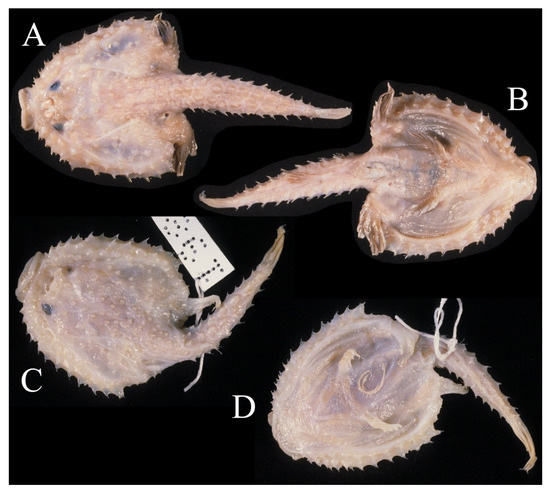
Figure 11.
Halieutopsis ingerorum Bradbury, 1988. (A,B). ZMMU P20363, 78.8 mm SL, South Africa. (C,D). MNHN 1986-0027, 70.1 mm SL, Madagascar. (A,C). Dorsal view. (B,D). Ventral view. Photos by M. G. Bradbury.
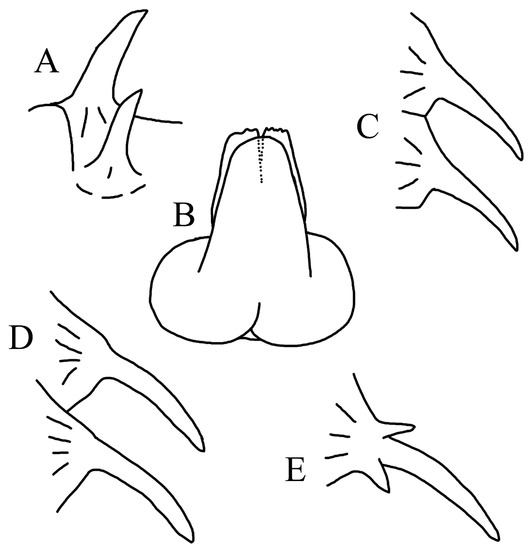
Figure 12.
Esca and squamation of H. ingerorum Bradbury, 1988, from MNHN 1986-0027, 70.1 mm SL. (A). Rostral tubercles. (B). Esca. (C). Tubercles on disk margin. (D). Tubercles on tail. (E). Subopercular tubercle.

Table 5.
Morphometric and meristic data of H. ingeroum and H. taiwanea sp. nov. * data taken from Bradbury (1988).
Synonymy. Halieutopsis ingerorum Bradbury [8]: 17 (Type locality: Mozambique Channel). Bradbury [2]: 7 (checklist).
Specimens examined. Holotype (Figure 11): CAS 57249 (44.2), 21°18′ S, 36°18′ E, Mozambique Channel, Western Indian Ocean, shrimp trawl, 1510–1600 m, 2 October 1964.
Non-types: Madagascar: MNHN 1986-0027 (1, 70.1), n.o.vauban, sta. ch126, 17°49′58.8″ S, 43°7′1.2″ E, 1475–1530 m, 16 January 1975 (Figure 11 and Figure 12). South Africa: ZMMU P20363 (ex. ZMMU P15816, 1, 78.8), 33°35′ S, 34°40′ E, off Durban, 1300–1380 m, 29 June 1979.
Diagnosis. Face strongly upturned; rostrum very short and small, tipped upwards, set back to anterior margin of eyes. Mouth relatively small, 17.5–18.6% SL, visible in dorsal view; jaws relatively short, 10.8–12.4% SL, strongly curved. Disk relatively small, 43.4–44.0% SL, ventral surface naked. Illicial cavity small and shallow, its width 9.2–9.3% SL (Table 5). All fins small. Principal tubercles on rostrum short and simple, those on tail and disk margin slender and pointed (Figure 12). Dorsal lobe of esca tongue-like with two flaps behind (Figure 11B). Lateral-line neuromasts: SS 3, POS 2, SOS 5, DBSS 2–3, vs. 2–3, TS 10–13 (Table 1 and Table 2).
Distribution. Likely restricted to southwestern Indian Ocean. Holotype from Mozambique Channel and two additional specimens from off Madagascar and South Africa, respectively (Figure 3). Bathymetric range 1300 m to 1600 m.
Remarks. Ho and Shao [4] reported three specimens from northeastern Taiwan; however, based on significant differences in body proportions from the present African specimens, the Taiwanese population is described herein as the new species Halieutopsis taiwanea (see below).
3.1.8. Halieutopsis kawaii sp. nov.
(Kawai’s deepsea batfish)
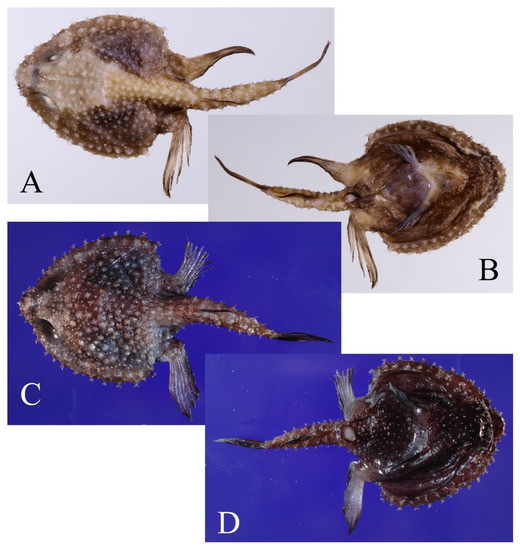
Figure 13.
Halieutopsis kawaii sp. nov. (A,B). Holotype, ASIZP66383, 79.4 mm SL, preserved, photos by C.-N. Tang. (C,D). Paratype, HUMZ194271, 83.6 mm SL, fresh, photos courtesy of HUMZ. (A,C). Dorsal view. (B,D). Ventral view.
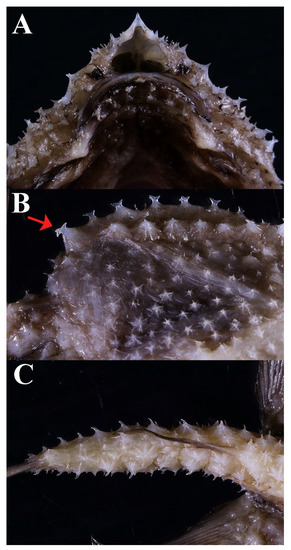
Figure 14.
Halieutopsis kawaii sp. nov., holotype. (A). Ventral view of rostrum and cheek. (B). Dorsal view of left disk margin, with arrow indicating subopercular tubercle. (C). Dorsal view of tail. Photos by C.-N. Tang.

Figure 15.
Esca and squamation of H. kawaii sp. nov., from holotype. (A) Rostral tubercle. (B) Esca. (C) Tubercle on disk margin. (D) Tubercle on tail. (E). Subopercular tubercle.

Table 6.
Morphometric and meristic data of three H. kawaii sp. nov.
Zoobank: urn:lsid:zoobank.org:act:067DA6DF-7747-4B1C-90C4-651E2A6A765A
Type series. Holotype (Figure 13, Figure 14 and Figure 15). ASIZP66383 (79.4), Ocean Researcher I, sta. CD 322, 20°44′42.4″ N, 117°39′13.8″ E, near Dongsha Atoll (Pratas Island), South China Sea, 1150–1908 m, otter trawl, 19 August 2005, coll. H.-C. Ho. Paratypes. HUMZ 193696 (1, 37.2), 4°34′ S, 101°9.5′ E, off Bengkulu Province, southern Sumatra, eastern Indian Ocean, 735–750 m, trawl net, 9 June 2005; HUMZ194271 (1, 83.6), 8°39.8′ S, 110°42.3′ E, off Daerah Istimewa Yogyakarta, southern Java, eastern Indian Ocean, 868–872 m, trawl net, 14 May 2005 (Figure 13); HUMZ194291 (1, 57.8), 8°43.7′ S, 111°21.0′ E, off Jawa Timur, southern Java, eastern Indian Ocean, 837–839 m, trawl net, 26 May 2005; HUMZ194613 (1, 56.8), 8°44.1′ S, 111°58.7′ E, off Jawa Timur, southern Java, eastern Indian Ocean, 895–930 m, trawl net, 25 May 2005; all collected by T. Kawai.
Non-types. ASIZP 64425 (2, 21.7–40.4), Ocean Researcher I, sta. CD 214, 24°28′38.3″ N 122°12′40.0″ E, off northeastern Taiwan, 488 m, 27 March 2003.
Etymology. Named for the author′ S friend, Dr. Toshio Kawai, Hokkaido University, who collected the paratypes of the present species and made them available for this study.
Diagnosis. Body dark brown, covered by simple tubercles on dorsal surface and relatively more sparsely scattered tubercles on ventral surface, with no small tubercles interspersed among them on either side of body. Principal tubercle on rostrum simple, with broad base bearing several small spines (Figure 14A and Figure 15A); principal tubercles on tail simple, never bifurcate (Figure 15D). Dorsal lobe of esca bearing pair of cirri on tip and two or three pairs of small lateral flaps (Figure 15B). Orbital diameter large, 11.6–14.0% (mean 12.7%) SL; interorbital space narrow 9.9–11.3% SL (mean 10.7%). Lateral-line neuromasts numbering 2–4 (mainly 3) in ventral series.
Description. Proportional measurements of type series as given in Table 1, meristics in Table 1, Table 2 and Table 6.
Dorsal-fin rays 4 (4–5); pectoral-fin rays 16 (14–16); anal-fin rays 4. Body disk depressed but robust, slightly longer than wide; disk relatively long and broad as reflected in proportions of head depth (20.9–27.7% SL) and disk margin length (41.7–44.7% SL). Rostrum consisting of three enlarged tubercles, of which principal tubercle simple, directed more upwards than forwards, with some small spines at its base (Figure 15A). Illicial cavity deep and broad, as wide as high or slightly wider, visible in ventral view (Figure 14B) but not especially extending forward. Dorsal lobe of esca leaf-like, with two small cirri on tip and two pairs of small lateral flaps (Figure 15B). Interorbital space relatively narrow (9.9–11.3% SL) compared to other congeners.
Principal tubercles on dorsal surface needle-like with usually 5–6 (rarely 7) facets, those on disk margin bifurcate (Figure 15C), those on tail and ventral since simple and never bifurcate (Figure 15D), and those on subopercle divided into three short spines, one directed forward, two directed backward (Figure 15E).
Lateral-line neuromasts: SS 6–7, PMS 1, CS 8, BS 9, POS 3, SOS 5–6 (mainly 5), DBSS 3, PBSS 3, vs. 2–4 (mainly 3), TS 10–12 (Table 1 and Table 2).
Coloration. Body generally grayish brown to dark brown when fresh, ventral surface and fins darker. Preserved specimens light gray with opercular regions, ventral surface and fins relatively dark (Figure 13).
Distribution. Known from the type series collected from the South China Sea southwest of Taiwan and from the eastern Indian Ocean off Indonesia (Figure 3). Holotype taken from within range of 1150–1908 m; paratypes collected at depths of 735–930 m.
Remarks. The present specimen was originally identified by the author as H. nasuta, but it clearly differs from H. nasuta in having only simple tubercles associated with the lateral line on the sides of the tail and in having a uniformly gray dorsal coloration, with no reticular pattern. This species is larger than its congeners, except for H. stellifera.
Two small non-type specimens (ASIZP 64425, 21.7–40.4 mm SL) were collected from northeastern Taiwan in a relatively shallow region (488 m). More investigation is needed to verify the population.
3.1.9. Halieutopsis margaretae Ho & Shao, 2007
(Margaret’s deepsea batfish)
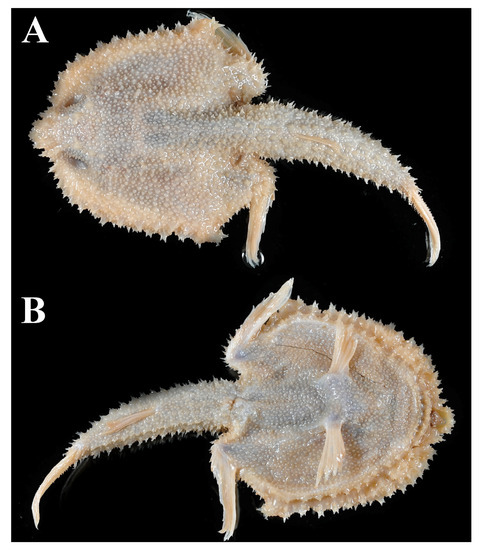
Figure 16.
Halieutopsis margaretae Ho & Shao, 2007, NSMT-P18963, nontype, 64.9 mm SL, Japan, photos courtesy of NSMT. (A) Dorsal view. (B) Ventral view.
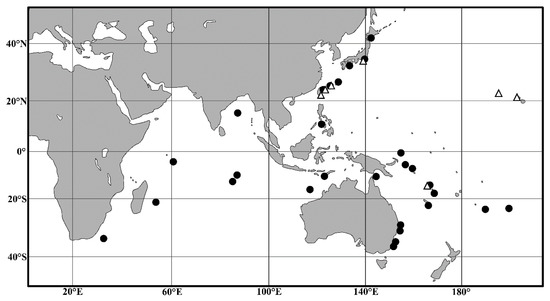
Figure 17.
Distribution map of H. margaretea (open triangles) and H. nudiventer (black dots). One dot may represent more than one capture.

Table 7.
Morphometric and meristic data of H. margaretae, H. murrayi sp. nov. and H. nasuta. * Data taken from Ho and Shao (2007).
Synonymy. Halieutopsis margaretae Ho & Shao [3]: 88 (Type locality: Western Pacific and central North Pacific). Ho & Shao [4]: 294 (Taiwan; in Key). Ho & Shao [22]: 38 (listed, southern Taiwan).
Specimens examined. Type series listed in Ho and Shao [3]. Non-types. Japan: NSMT P66396 (1, 42.2), 26°15.1′ N, 125°17.2′ E, East China Sea north of Miyako and west of Kume islands in the Ryukyus, 955–991 m, 26 April 2002 (Figure 16). Taiwan: ASIZP 66987 (1, 33.0), 24°23.65′ N, 122°14.13′ E, northwestern Taiwan, beam trawl, 1219 m, 26 August 2006; FRIP 01051 (1, 74.0), 22°51.9′ N, 121°25.2′ E, southeastern Taiwan, bottom trawl, 2 August 2000. Vanuatu: MNHN 1997-4035 (1, 44.5), musorstom 8, n.o. alias, 15°57′0″ S, 166°37′58.8″ E, Coral Sea, 1160–1220 m, 10 October 1994.
Diagnosis. Body subtriangular; covered with complex tubercles: those on rostrum, disk margins, and subopercle with 4–7 spines, those on ventral surface bicurcate, and those on tail tridentate [3]. Head relatively short (28.3–31.6% SL); interorbital space narrow (8.3–10.5% SL); disk relatively small as indicated by small pre-anus length (53.0–60.5% SL) and short disk margin (38.3–42.7% SL) (Table 7). Lateral-line neuromasts: SS 6; POS 2–3 (mainly 3); and vs. 1–2 (mainly 2). Body uniformly dark gray when fresh, creamy white to light gray when preserved.
Distribution. Known from the Western Pacific off Ryukyus Islands, Japan, Taiwan, and Vanuatu (Figure 17). Bathymetric range 445 m to 1220 m.
Remarks. Halieutopsis margaretae is unique in the genus by having bifurcated tubercles on the ventral surface like those found in species of Solociaquama Bradbury, 1999 and Dibranchus [9]. It is also the only member of the genus with a remnant of the second dorsal-fin spine [3]. Both features, being plesiomorphic in this species, may suggest that H. margaretae represents a late phylogenetic branch within the genus.
Although the holotype was collected from a depth between 445 m and 1185 m and one paratype was collected from a depth between 100 m and 800 m, the other specimens were collected from 684–729 m down to 1220 m, which suggests that this species inhabit the upper continental slope.
3.1.10. Halieutopsis murrayi sp. nov.
(Murray’s deepsea batfish)
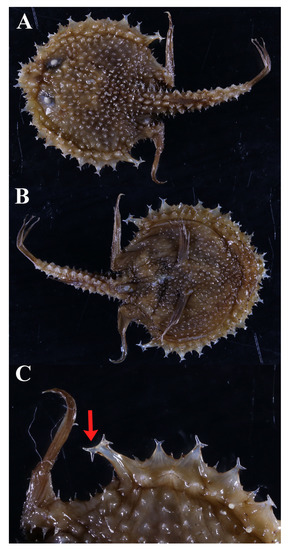
Figure 18.
Halieutopsis murrayi sp. nov., holotype, BMNH 1939.5.24.1912, 48.7 mm SL. (A). Dorsal view. (B). Ventral view. (C). Dorsal view of left disk margin, with arrow indicating subopercular tubercle.
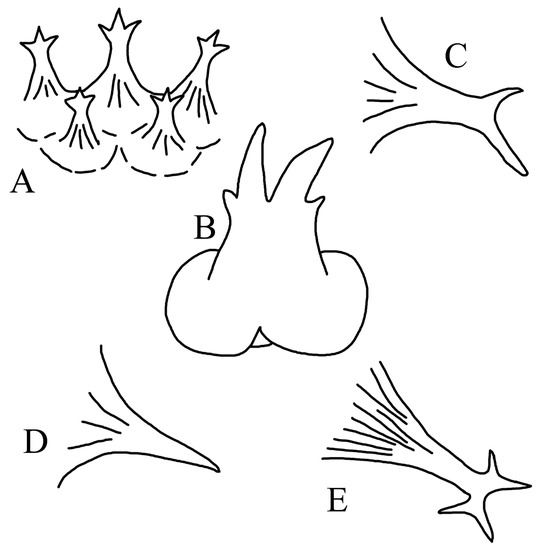
Figure 19.
Esca and squamation of H. murrayi sp. nov., from holotype. (A). Rostral tubercles. (B). Esca. (C). Tubercle on disk margin. (D). Tubercle on tail. (E). Subopercular tubercle.
Zoobank: urn:lsid:zoobank.org:act:EBA24F20-157D-4B5E-AB0F-133317E5EA05
Synonymy. Dibranchus nasutus (non Alcock [7]): Norman [20]: 113 (Gulf of Aden).
Holotype (Figure 18 and Figure 19). BMNH 1939.5.24.1912 (48.7), John Murray Expedition, sta. 184, Yemen, Gulf of Aden, Arabian Sea, 1270 m.
Etymology. The species is named after Sir John Murray (1841–1914) in recognition of his contributions to modern oceanography and with reference to the John Murray Expedition, during which the holotype was collected.
Diagnosis. Body uniformly black. Principal tubercles on rostrum trifid; subopercular tubercle elongated and divided into four spinelets distally (Figure 18C). Following features all present in combination: Tubercles on dorsal and ventral surfaces and tail all simple, rather apart from each other with naked skin in between; tubercles on disk margin somewhat depressed, bifurcate at tip; tubercles on dorsal surface with 5–8 facets; dorsal lobe of esca bearing two pairs of cirri; head narrow, 26.9% SL; interorbital space narrow, 8.2% SL; illicial cavity narrow, 7.0% SL; all fins relatively long (dorsal-fin length 19.1% SL, pectoral-fin length 31.6% SL, anal-fin length 19.7% SL and caudal-fin length 31.0% SL).
Description. Proportional measurements of the specimen, expressed in percent of SL are given in Table 7. Meristics are given in Table 1, Table 2 and Table 7.
Disk subtriangular, longer than wide (Figure 18). Rostrum a broad, rounded shelf, well overhanging mouth; tubercles on rostrum sharp, trifid at tip (Figure 19A). Iillicial cavity slightly compressed, its opening higher than wide, completely visible in ventral view; dorsal lobe of esca leaf-like, bearing two small cirri on tip and pair of small appendages at base (Figure 19B). Eyes moderate in size. Villiform teeth in narrow bands on jaws, those of upper jaw not visible when mouth closed.
Principal tubercles on dorsal surface sharp and needle-like, usually with 5–6 facets; those on disk margin somewhat depressed at base, bifurcate at tip (Figure 19C); those on subopercle divided into four spinelets, two directed forwards and two backwards (Figure 18C and Figure 19E); those on dorsal and ventral surfaces of tail simple, loose in arrangement; those associated with lateral-line scales on lateral sides of tail simple (Figure 19D), with no smaller tubercles between them. Lateral-line neuromasts: SS 6: PMS 1, CS 8, BS 9, POS 3, SOS 6/7, DBSS 3, PBSS 3, TS 9, vs. 2/3 (Table 1 and Table 2).
Distribution. Represented only by holotype collected from Gulf of Aden at depth of 1270 m.
Comparison. Halieutopsis murrayi sp. nov. differs from its congeners in having an elongated subopercular tubercle with two pairs of symmetrical spinelets at its tip and a uniformly black body. It is similar to H. oblonga in having similar appearance, but besides having a differently constructed subopercular tubercle as just mentioned, the tubercles on the disk margin are more depressed and those on the dorsal and ventral surfaces and tail are farther apart and more slender than in H. oblonga. Another similar species is H. nasuta, but the new species differs from it in having trifid tubercles on the rostrum, simple tubercles on the tail, and no vermiculate color pattern on the body.
Remarks. Norman [20] reported the present specimen as Dibranchus nasutus. On account of its several distinct characteristics, we here recognize it as representing a hitherto undescribed species.
3.1.11. Halieutopsis nasuta (Alcock, 1891)
(Big-nosed deepsea batfish)
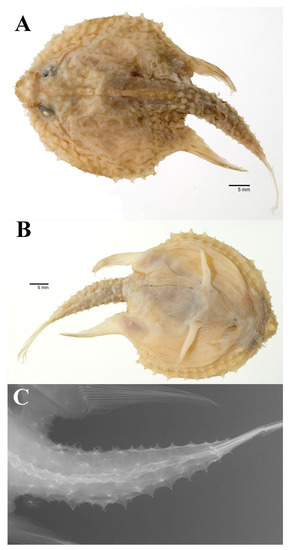
Figure 20.
Halieutopsis nasuta (Alcock, 1891), holotype of junior synonym H. vermicularis Smith & Radcliffe, 1912, USNM 70272, 60.9 mm SL. (A). Dorsal view. (B). Ventral view. (C). Radiograph showing tail tubercles. Photos by S. Raredon, courtesy of USNM.
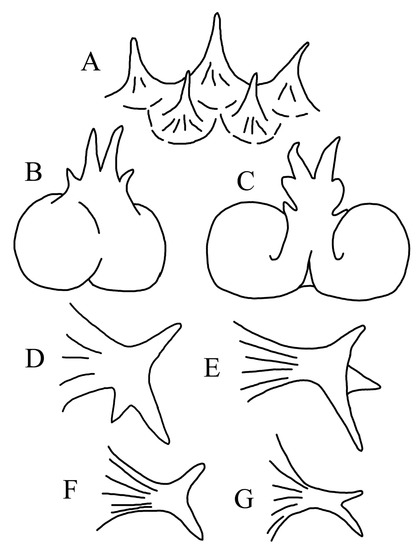
Figure 21.
Esca and squamation of H. nasuta (Alcock, 1891). (A). Rostrum. (B,C). Esca. (D,E). Subopercular tubercle. (F). Tubercle on disk margin. (G). Tubercle on tail. (A,B,D). From BMNH 1898.7.13.5, 46.0 mm SL. C. From AMS I.22826-048, 57.8 mm SL. (E–G). From AMS I.20301-009, 30.0 mm SL.
Synonymy. Dibranchus nasutus Alcock [7]: 24, pl. 7, Figure 1 (type locality: Andaman Sea). Alcock [23]: pl. 20, Figure 2 (illustration). Alcock [24]: 63 (descriptive catalogue, Andaman Sea and off Travancore coast, India). Bradbury [2]: 14 (checklist, incertae sedis in Halieutopsis).
Halieutopsis vermicularis Smith & Radcliffe [5]: 209, pl. 20, Figure 1, pl. 21, Figure 1 (type locality: the Philippines). Bradbury [6]: 412 (Philippines to southern Japan). Bradbury [8]: 15 (in part; redescription, Japan, Philippines to northern New Guinea). Bradbury [16]: 2025. Bradbury in Randall & Lim [17]: 598 (checklist). Bradbury [2]: 8 (checklist).
Halieutopsis cf. vermicularis: Bradbury [9]: 260 (assigned to Halieutopsis).
Specimens examined. Holotypes. H. nasutus: ZSI 13028, broken bony remains inextricably mixed in same jar with those of another individual. H. vermicularis: USNM 70272 (female, 60.9), holotype, Albatross sta. D.5365, Cape Santiago Lighthouse, Balayan Bay, Luzon, Philippine, 13°44′24″ N, 120°45′28.8″ E, 25 foot Agassiz beam trawl, 391 m, 22 February 1909 (Figure 20). Non-types. Eastern Australia: AMS I.20301-009 (2, 33.0–34.0), 29°53′ S, 153°42′ E, east of Wooli, New South Wales, prawn trawl, 502 m, 23 August 1977 (Figure 21); AMS I.26446-004 (1, 28.0), 33°34′ S, 151°59′ E, Broken Bay, Sydney, New South Wales, 421–457 m, 14 November 1985; AMS I.32439-004 (1, 30.5), R/V Franklin, 10°37.17′ S, 144°21.99′ E, east of Yule Entrance, Coral Sea, beam trawl, 990–1053 m, 21 August 1988; CSIRO H 947-20 (1, 60.0), 22°56′ S, 154°21′ E, South Saumarez Reef, Queensland, lobster trawl, 590–606 m, 17 November 1985; QM 15819 (2, 32.5-37.2), 11°32′ S, 144°10′ E, E of Raine Island, Queensland. Western Australia: AMS I.22808-048 (4, 60.0-61.0), 17°59′ S, 118°17′ E, Northwest Shelf, Engel trawl, 404–420 m, 3 April 1982 (Figure 21); AMS I.22826-018 (1, 57.8), 18°44′ S, 117°02′ E, Northwest Shelf, Engel trawl, 396–406 m, 13 April 1982; CSIRO B3295 (1 of 5, 45.9), and CSIRO B4137 (1, 49.4), 18°07′ S, 118°09′ E, SW of Imperieuse Reef, Northwest Shelf, prawn trawl, 400–404 m, 5 February 1983; CSIRO CA3568 (1, 71.6), 17°53′ S, 118°26′ E, SW of Imperieuse Reef, Northwest Shelf, prawn trawl, 442–460 m, 5 February 1983; CSIRO H 2084-4 (1, 48.5), 17°01′ S, 120°13′ E, Rowley Shoals, prawn trawl, 392 m, 13 April 1989; CSIRO H 2110-01 (1, 51.9), 16°59′ S, 120°13′ E, Rowley Shoals, prawn trawl, 405 m, 5 April 1989; CSIRO H 2128-06 (1, 52.8), 17°50′ S, 118°33′ E, Rowley Shoals, bottom trawl, 420 m, 12 February 1989; CSIRO H 2555-01 (1, 66.1), 23°25′ S, 113°03′ E, Alison Point, Engel trawl, 297–311 m, 26 Jan 1991; CSIRO H 4071-05 (1, 35.2), 18°06′ S, 118°10′ E, Rowley Shoals, demersal trawl, 388–392 m, 9 September 1995; NTM S.11590-004 (2, 46.5–49.0), FRV Soela, sts. ASO 283, 18°33′ S, 117°31′ E, Northwest Shelf, 392–400 m, 25 Apr, 1983, coll. A. J. Bruce; NTM S.12592-002 (2, 53.6–57.5), 17°24′ S, 118°54′ E, off Rowley Shoals, 445 m, 3 November 1985, coll. W. Houston; NTM S.12608-003 (1, 56.7), 17°51′ S, 118°27′ E, off Rowley Shoals, 415 m, 7 November 1985, coll. W. Houston; NTM S.12609-008 (1, 59.8), 17°39′ S, 118°40′ E, off Rowley Shoals, 420 m, 7 November 1985, coll. W. Houston; NTM S.12610-011 (3, 55.6–58.4), 17°52′ S, 118°28′ E, off Rowley Shoals, Northwest Shelf, 415 m, 7 November 1985, coll. W. Houston; WAM P.28058.017 (2, 32.2–53.9), 18°05′ S, 118°10′ E, off Rowley Shoals, 400 m, 17 August 1983; WAM P.30578.003 (1, 36.0), 17°57′00″ S, 118°17′00″ E, Northwest Shelf, 450–454 m, 27 January 1987. Pacific Ocean: SIO 70-314, 10 mm SL, 23°45.3′ N, 142°12.0′ E, North Pacific Ocean, 0–1425 m, 2 September 1970. Philippines: MNHN 1988-0384 (1, 53.6), 13°8′0″ N, 122°39′0″ E, Sibuyan Sea, 280–440 m, 25 November 1980; SIO 70-346 (1, 14.0), R/V Melville, 14°34′36″ N, 119°33′36″ E, 0–1500, 19 September 1970; USNM 182931 (2, 59.4–76.8), Philippines Expedition, 1907-1910, Albatross sta. D.5115, 13°37′10.9″ N, 120°43′40.8″ E, Balayan Bay and Verde Island Passage, Sombrero Island, 622 m, 20 January 1908. Vanuatu: MNHN 1997-4031 (1, 68.4), musorstom 8, n.o. alis, 18°48′0″ S, 168°54′0″ E, Coral Sea, 780–783 m, 24 September 1994; MNHN 2008-2481 (1), boa 1, n.o. alis, cp2470, 16°27′37.2″ S, 167°53′40″ E, east of Malekula Island, 568–591 m, 14 September 2005. New Caledonia: MNHN 2000-0327 (2, 30.6–62.5), musorstom 4, n.o. vauban, sta. cp170, 18°57′0″ S, 163°12′0″ E, Coral Sea, 485 m, 17 September 1985; MNHN 2000-0328 (1, 39.2), musorstom 4, n.o. vauban, sta. cp 236, 22°11′31.2″ S, 167°15′0″ E, Coral Sea, 495–550 m, 2 October 1985; MNHN 2000-0329 (1, 72.8), musorstom 4, n.o. vauban, sta. cc202, 18°58′1.2″ S, 163°10′58.8″ E, Coral Sea, 580 m, 20 September 1985; MNHN 2000-0330 (1, 42.4), 22°6′0″ S, 167°10′0″ E, 500–550 m, 3 October 1985; MNHN 2002-3204 (1, 30.9), musorstom 4, n.o. vauban, sta. dw197, 18°51′28.8″ S, 163°6′0″ E, 560 m, Coral Sea, 20 September 1985; MNHN 2003–1899 (1, 26.4), 18°54′5″ S, 163°11′0″ E, Coral Sea, 600 m, 17 September 1985.
Solomon Islands: MNHN 2006-0694 (1, 25.7), 8°24′24″ S, 159°24′12″ E, off Santa Isabel Island, 335–432 m, 24 October 2004. Indonesia: USNM 151184 (1, juvenile, 21.8), Philippines Expedition 1907-1910, Albatross sta. D.5654, 4°43′50.2″ S, 121°23′24″ E, Gulf of Boni, Buginkali Point, south of Sulawesi, 1280 m, 17 December 1909. HUMZ 194740 (1, 44.0), 8°27.2′ S, 110°39.3′ E, off Yogyakarta, southern Java, eastern Indian Ocean, 353–359 m. Andaman Sea: BMNH 1898.7.13.5 (1, 46.0), ca. 740 m (sent by Alcock).
Diagnosis. Black to brown vermiculate color pattern on dorsal surface (Figure 20A). Principal tubercles on dorsal surface with 5–8 facets; ventral surface naked or with scattered tubercles; bifurcate tubercles associated with lateral line on tail (Figure 20C). Dorsal lobe of esca with pair of cirri at tip and small appendage on each side of its base. Following proportional measurements relatively large: Skull length 28.7–36.8% SL, interorbital width 11.3–13.3% SL, mouth width 23.9–30.7% SL, upper jaw length 15.1–17.6% SL, post-anus length 61.7–67.8% SL, preanal length 74.9–85.0% SL, disk margin 43.4–52.3% SL, dorsal-fin length 14.8–19.1% SL, pectoral-fin length 26.1–31.2% SL, anal-fin length 16.1–20.2% SL, caudal-fin length 24.3–33.1% SL. Lateral-line neuromasts: POS 3–4, SOS 5–6, DBSS 3, vs. 3–4, TS 8–10 (Table 1 and Table 2).
Description. Proportional measurements and meristics of specimens as given in Table 7. Following description based on all available materials.
Body strongly depressed, head slightly elevated anteriorly. Disk broad and subtriangular, equally wide as long (Figure 20A). Rostrum forming obtuse bony shelf well overhanging mouth, consists of three simple, enlarged, upward- and forward-directed tubercles (Figure 21A). Illicial cavity a deep concavity, its opening equally wide and high, visible in ventral view. Esca with three lobes: Large, leaf-like dorsal lobe with two small cirri on tip and one or two pairs of small appendages at its base, and pair of rounded ventral lobes (Figure 21B,C).
Tubercles on dorsal surface moderately large in size, usually with 5–8 facets, those on disk margin bifurcate at tips (Figure 21F), those on subopercle divided into 4 short spines (Figure 21E), those on dorsal and ventral sides of tail simple, never bifurcate, and those associated with lateral line on tail bifurcate at tip (Figure 21G). Lateral-line neuromasts: PO 3–4, SO 5–6, DS 3, PS 3, C 7, PM 0, SO 7–8, ST 8, V3–4, T 8–10 (Table 1 and Table 2).
Coloration. Uniformly black in freshly preserved specimens, usually with white, tubercle-defined vermiculate pattern; ventral surface also blackish but paler between pelvic fin bases, darker on chin and outside gill chambers; anus pale; all fins darker than ground color, except paler undersides of pectoral fins (Figure 20A,B).
Distribution. Halieutopsis nasuta appears to be a tropical species, being widespread in the eastern Indian Ocean as well as the Solomon Islands, New Caledonia, Vanuatu, and Australia in the Western Tropical Pacific (Figure 6). Specimens were collected at depths of 297–1141 m, mainly between 300 and 600 m.
Comparison. Halieutopsis nasuta is similar to H. echinoderma in having similar morphological proportions but differs from the latter in having bifurcate principal tubercles associated with the lateral-line scales on the tail, just a few or no tubercles on the ventral surface and a smaller eye (9.7–12.9% SL, vs. 13.5–16.2% SL). It is also similar to H. stellifera but differs in having a narrower interorbital space (10.3–13.3% SL, vs. 14.0–20.6% SL), a more depressed body disk, bifurcate tubercles associated with the lateral-line scales on the tail, and just a few or no tubercles on the ventral surface.
Remarks. Bradbury [9] and the author (pers. obs., 2013) examined the type specimen of Dibranchus nasutus (ZSI 13028), now fragmented and mixed with fragments of a non-type specimen in a jar with one tag showing “ZSI 13028”. Not many features can be confirmed from those remains, except for the morphology of the esca, which allowed Bradbury [9] to recognize it as a member of Halieutopsis similar to, e.g., H. vermicularis. Some tubercles with 7–10 facets are present, as well as some bifurcate tubercles along the tail margin, both being diagnostic characters of the species. Another specimen (BMNH 1898.7.13.5), identified as Dibranchus nasutus and evidently sent by Alcock himself, is identical with Alcock’s original description in all respects and provides a better understanding of the species. Alcock [24] provided four specimens additional to the holotype collected from Andaman Sea and off Travancore, southern India. One of the depths recorded is 405 fathoms (=740.7 m) which was likely the same specimen sent to BMNH by Alcock.
Because it can be clearly diagnosed based on Alcock’s non-type specimen and the holotype of its junior synonym H. vermicularis and is readily separable from its most closely related congeners, designation of a neotype would not be justified under Article 75 of the International Code of Zoological Nomenclature [11].
Examination of all the known specimens listed above has confirmed that H. nasuta is a valid species and also a senior synonym of H. vermicularis, but also revealed that some specimens were misidentified. Brauer [21] mentioned a supposed specimen of Dibranchus nasutus collected from the east coast of Africa (specimen not examined, 33 mm TL, Valdivia sta. 250, 1°47′8′′ S, 41°58′8′′ E, 1668 m); based on his description, this is most likely H. nudiventer (see below). Smith and Radcliffe [5] provided a photograph of a specimen of Dibranchus nasuta from the Philippines that could be neither located for the present study (perhaps never catalogued; Ho, pers. obs.) nor identified from the photo. Weber [25], followed by Weber and de Beaufort [26], mentioned four specimens identified as Dibranchus nasutus; these are reidentified herein as H. nudiventer (1, 24.4 mm), H. oblonga (1, 46.1 mm, see below), and Dibranchus obscurus (2, 55.1–110.7 mm). Norman’s [20] supposed specimen of Dibranchus nasutus from the Gulf of Aden (BMNH 1939.5.24.1912) has been designated in the present work as the holotype of a new species, H. murrayi.
Three specimens collected off Japan that Bradbury [8] recognized as H. vermicularis, as well as other Japanese specimens identified as H. vermicularis by Shimazaki et al. [13] among the comparative materials used in their redescription of H. bathyoreos, are all reidentified as H. nudiventer in the present work.
3.1.12. Halieutopsis nudiventer (Lloyd, 1909)
(Naked-belly deepsea batfish)

Figure 22.
Halieutopsis nudiventer (Lloyd, 1909). (A,C). Dorsal view. (B,D). Ventral view. (A,B). AMS I.29757-002, 74.7 mm SL. (C,D). NSMT-P101904, 70.4 mm SL, photos courtesy of NSMT.
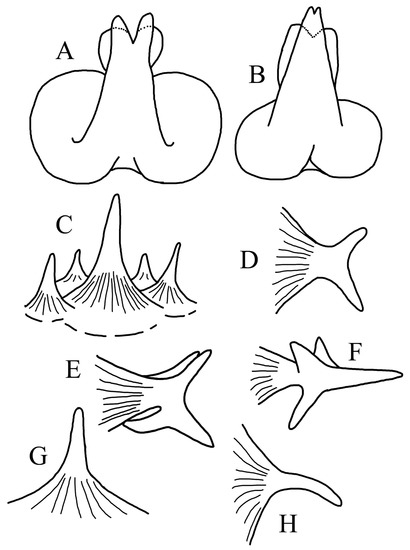
Figure 23.
Esca and squamation of H. nudiventer (Lloyd, 1909). (A,C–E,G–H). AMS I.29757-002, 74.7 mm SL. (B,F). From BMNH 1939.5.24.1914, 49.1 mm SL. (A,B). Esca. (C). Rostral tubercles. (D). Tubercle on disk margin. (E,F). Subopercular tubercles. (G). Tubercle on dorsal surface (up to 14 facets). (H). Tubercle on tail.
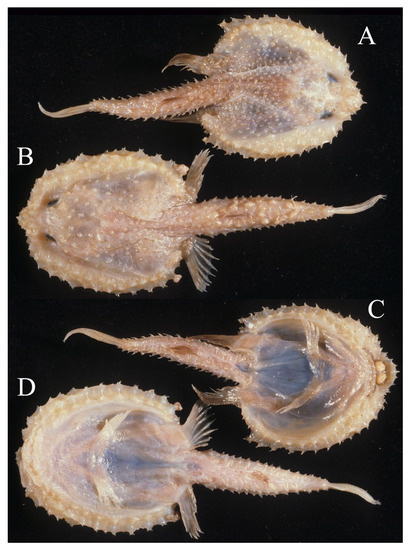
Figure 24.
Comparison of dermal squamation and rostrum of H. bathyoreos Bradbury, 1988 (A,C, 61.6 mm SL) and H. nudiventer (Lloyd, 1909) (B,D, 69.8 mm SL), both in ZMMU P15810, 2 of 4, photos by M. G. Bradbury.

Table 8.
Morphometric and meristic data of H. nudiventer, H. oblonga, and H. okamurai sp. nov.
Synonymy. Dibranchus nudiventer Lloyd [10]: 168 (original description based only on holotype ZSI 1127/1, now lost). Bradbury [6]: 415 (nominal species in Dibranchus, type not examined). Bradbury [9]: 261 (re-assignment to Halieutopsis; possible synonym of H. vermicularis). Bradbury [2]: 14 (checklist; insertae sedis in Halieutopsis).
Dibranchus nasutus (non Alcock [7]): Brauer [21]: 328 (east coast of Africa, specimen not examined). Weber [25]: 568 (in part, one of four specimens is H. nudiventer). Weber & de Beaufort [26]: 226 (after Weber [25]).
Halieutopsis vermicularis (non Smith & Radcliffe [5]): Bradbury [8]: 15 (in part, three specimens collected from Japan, misidentification); Shimazaki et al. [13]: 124 (in part, comparative material).
Specimens examined. Non-ypes. Japan: BSKU 19683 (1, 54.2), 34°21.3′ N, 139°37.3′ E, off Izu Island, beam trawl, 920–955 m, 18 February 1966; BSKU 19893, 19894 (2, 30.8–49.2), 33°55.1′ N, 140°00.5′ E, off Izu Island, beam trawl, 860–870 m, 1 December 1968; BSKU 19938 (1, 40. 6), 34°03.5′ N, 140°04.7′ E, off Izu Island, beam trawl, 1270 m, 29 June 1969; BSKU 26449 (1), 26°20.1′ N, 124°50.7′ E, Okinawa Trough, bottom trawl, 1000–1140 m, 22 January 1978; BSKU 44257 (1, c & s), Tosa Bay, otter trawl, 600 m, 17 November 1987; BSKU 44782 (1, 67.2), Tosa Bay, otter trawl, 700 m, 24 May 1988; BSKU 47924 (1, 53.8) and BSKU 47925 (1, 42.2), 32°26.09′ N, 133°50.94′ E, off Tosa Bay, 1316–1542 m, 2 September 1990; BSKU 76564 (1, 62.6), off Hagachizaki, Suruga Bay, 3 m ORE beam trawl, 990–1010 m, 14 November 1983; BSKU 76565, 6566, 76567 (3, 42.4–58.3), 27°06.8′ N, 128°41.9′ E, off Yoron Island, Kagoshima, 870–945 m, 24 February 1973; USNM 135661 (1, 36.9), Albatross North Pacific Expedition 1906, Albatross sta. D.5083, 34°04′19.9″ N, 137°57′28.8″ E, Omai Saki Light, 1141 m, 20 October 1906; USNM 135694 (2, 24.4–27.0), North Pacific Expedition 1906, Albatross sta. D.4980, 34°09′ N, 137°55′12″ E, Honshu, 927 m, 1 September 1906; USNM 150449 (1, 33.0), North Pacific Expedition 1906, Albatross sta. D.4957, 32°36′ N, 132°23′ E, Mizunoko Shima Light, 799 m, 23 August 1906; USNM 197661 (1, 42.7), North Pacific Expedition 1906, Albatross sta. D.5044, 42°10′40″ N, 142°14′ E, Hokkaido, 565–657 m, 3 October 1906. Taiwan: ASIZP 64422 (1, 34.0) and ASIZP 65402 (1, 47.0), 24°28.8′ N, 122°12.6′ E, northeastern Taiwan, 445 m, 13 May 2003. The Philippines: MNHN 2003-2397 (1, 37.0), musorstom 3, n.o. coriolis, sta. cp123, 12°10′4.8″ N, 121°45′0″ E, 700–702 m, 4 June 1985. Indonesia: ZMA 123.866 (1, 24.4), Siboga sta. 300, 10°48.6′ S, 123°23.1′ E, Timor Sea, 918 m. Papua New Guinea: BSKU 53307 and BSKU 53308 (2, 34.9–38.8), 2° S, 157° E, beam trawl, St. 19, 4 January 1968. Solomon Islands: MNHN 2005-2577 (2, 29.4–39.9), salomon 2, sta. cp2230, 6°35′16.8″ S, 156°22′1.2″ E, 837–945 m, 29 October 2004; MNHN 2006-0029 (1, 50.4), salomon 2, sta. cp2232, 6°25′8.4″ S, 156°23′2.4″ E, 1045–1207 m, 29 October 2004; MNHN 2006-0243 (3, 27.4–33.2), salomon 2, sta. sp2288, 8°36′10.8″ S, 157°28′22.8″ E, 509–520 m, 7 November 2004; MNHN 2006-0673 (1, 41.2), salomon 2, sta. sp 2185, 8°16′33.6″ S, 160°4′33.6″ E, 430 m, 23 October 2006. Vanuatu: MNHN 1997-4029 (1, 32.3), musorstom 8, n.o. alis, sta. cp956, 20°33′0″ S, 169°34′58.8″ E, Coral Sea, 1175–1212 m, 20 September 1994; MNHN 1997-4036 (4, 29.6–39.0), musorstom 8, n.o. alis, sta. cp1125, 15°57′0″ S, 166°37′58.8″ E, Coral Sea, 1160–1220 m, 10 October 1994; MNHN 1997-4052 (2, 28.4–37.3), musorstom 8, n.o. alis, 15°58′1.2″ S, 166°40′1.2″ E, Coral Sea, 1210–1260 m, 10 October 1994; MNHN 1997-4053 (1, 31.5), musorstom 8, n.o. alis, sta. cp990, 18°51′0″ S, 168°49′58.8″ E, 980–990 m, Coral Sea, 24 September 1994; MNHN 1997-4104 (1, 25.4), musorstom 8, n.o. alis, sta. cp1110, 14°49′1.2″ S, 167°15′0″ E, Coral Sea, 1360 m, 8 October 1994; MNHN 1997-4105 (1, 41.2), musorstom 8, n.o. alis, sta. cp1111, 14°51′0″ S, 167°13′58.8″ E, Coral Sea, 1210–1250 m, 8 October 1994. New Caledonia: MNHN 2002-0237 (1, 26.0), chalcal 2, sta. cp21, 24°54′0″ S, 168°21′0″ E, Coral Sea, 500 m, 28 October 1986; MNHN 2005-1145 (4, 21.6–25.8), biocal, n.o. jean-charcot, sta. cp30, 23°9′0″ S, 166°40′1.2″ E, Coral Sea, 1140 m, 29 August 1985. South Pacific Ocean: MNHN 2005-3300 (1, 58.7), 23°54.01′ S, 161°39.07′ W, southwest of Cook Islands, Polynesia, 982–989 m, 26 February 2002; MNHN 2005-3301 (1, 62.7), 23°57′ S, 169°42′ W, Polynesia, 593 m, 11 June 2002. Eastern Australia: AMS I.26001-006 (1, 24.0), 33°29′ S, 152°12′ E, off Broken Bay, New South Wales, bottom trawl, 1143–1200 m, 12 February 1986; AMS I.27038-001 (1, 22.0), 32°56′ S, 151°50′ E, off Newcastle, New South Wales, 1040–1075 m, 9 October 1982; AMS I.29591-003 (1, 73.3), 31°46′ S, 153°18′ E, Crowdy Bay, New South Wales, bottom trawl, 1005–1040 m, 21 June 1988; AMS I.29747-006 (3, 50.4–55.4), 32°49′ S, 152°47′ E, Nelson Bay, New South Wales, prawn trawl, 840–935 m, 3 December 1988; AMS I.29757-002 (1, 74.7), 32°52′ S,152°47′ E, southeast of Nelson Bay, New South Wales, eastern Australia, bottom trawl, 933–988 m, 2 August 1989 (Figure 22 and Figure 23); AMS I.29804-003 (1, 63.8), 33°05′ S, 152°35′ E, Newcastle, New South Wales, bottom trawl, 896–960 m, 16 May 1989; AMS I.29808-003 (1, 70.0), 32°52′ S, 152°47′ E, Newcastle Bight, New South Wales, bottom trawl, 1090–1134 m, 11 April 1989; AMS I.32439-001 (1, 27.9), 10°37.17′ S, 144°21.99′ E, Coral Sea, Queensland, bottom trawl, 990–1053 m, 21 August 1988. Western Australia: AMS I.22818-019 (1, 13.7), 18°27′ S, 116°33′ E, North West Shelf, Engel trawl, 800–1280 m, 8 April 1982; NMV A29670-018 (1, 61.3), 18°34′20″ S, 117°27′50.4″ E, 401–405 m, Northwest Shelf, 14 June 2007. Indian Ocean: ZMMU P15810 (1 of 4, male, 96.8), 14°51′ S, 86°49′ E, southwest of Cocos (Keeling) Islands, 1760 m, 19 March 1979; ZMMU P15813 (1, 76.9), 11°25′ S, 88°52′ E, west of Cocos (Keeling) Islands, 1600 m, 14 June 1977; ZMMU P20815 (1, 73.0), 9°48′ S, 60°42′ E, southeast of Amirante Islands, 1650 m, 2 September 1977. Réunion: MNHN 1994-0039 (2, 38.0–42.0), n.o. marion-dufresne, sta. cp140, 20°41′0″ S, 55°38′0″ E, 1612–1690 m, 3 September 1982. South Africa: ZMMU P15816 (1, 77.5), 33°35′ S, 34°40′ E, off Durban, 1300–1380 m, 29 June 1979. Provisionally referred specimens: BSKU 19124 (1, 25.3), 34°07′18″ N, 140°02′18″ E, off Izu Islands, Japan, beam trawl, 1320 m, 4 March 1960; CSIRO H 3145-33 (1, 59.4), 17°52′ S, 118°16′ E, Imperieuse Reef, Rowley Shoals, Western Australia, prawn trawl, 550 m, 22 February 1992.
Diagnosis. Principal tubercles on dorsal surface with 10–14 facets, very loosely scattered. Tubercle on tip of rostrum simple and elongated, directed upwards, tubercles on disk edge strongly depressed at base and bifurcate at tip, those on tail all simple and only associated with lateral line, none found ventrally. Head width relatively large (23.3–30.7% SL); interorbital space relatively narrow (8.5–11.8% SL). Usually only single lateral-line neuromast in ventral series.
Head and disk rather depressed, with cranium somewhat elevated from surface of disk; disk oval, slightly longer than wide. Rostrum a small shelf slightly projecting from head and overhanging mouth; tubercle on rostrum tip a simple spine, directed upwards (Figure 23C). Illicial cavity slightly depressed, its opening wider than high, barely visible in ventral view. Esca with three lobes: Large, leaf-like dorsal lobe with two small flaps on its tip, and pair of rounded ventral lobes (Figure 23A,B).
Eyes relatively small, oval, directed laterally and upwards. Mouth moderate, slightly concave, with upper jaw overlying lower jaw; two small and well-separated patches of teeth on ceratobranchial V. Principal tubercles on dorsal surface very loosely scattered arrangement, needle-like, usually with 10–14 facets (Figure 23G); those on disk margin bifurcate and depressed at base (Figure 23D), those on subopercle divided into 3–4 short spines (Figure 23E,F) and those on tail simple, never bifurcate (Figure 23H). Ventral surface of disk and tail naked except for 2–6 tubercles at pelvic fin bases, tail armed only with tubercles associated with lateral line. Lateral-line neuromasts: SS 3–6, PMS 0–1, CS 8, BS 8–9, POS 2–3 (mainly 2), SOS 5–6 (mainly 5), DBSS 3, PBSS 3, vs. 1–2 (mainly 1), TS 8–11 (mainly 8–9) (Table 1 and Table 2).
Distribution. Widespread in the Indo-West Pacific off Japan, Taiwan, Philippines, Melanesia (New Caledonia, Vanuatu and Solomon Islands), Australia, Réunion, and South Africa (Figure 17). Bathymetric range 430–1760 m, usually less than 1000 m.
Comparison. Halieutopsis nudiventer is most similar to H. bathyoreos, another species that lacks ventral tubercles except for a few on the pelvic fin base and occasionally around the anus (Figure 24). It is easily distinguished from the latter, however, by its relatively narrow rostrum that does not extend much beyond the mouth (vs. a broad, shelf-like rostrum that extends well anteriorly to the mouth; cf. Figure 24B vs. Figure 24A); the fact that the esca is not visible, or only partly visible, in ventral view (vs. entirely visible in ventral view; cf. Figure 24D, vs. Figure 24C); the relatively few, scattered tubercles with 10–14 facets on the dorsal surface of the disk (vs. a greater number of more densely arranged tubercles with 6–18 facets); the presence of mainly just one lateral-line neuromast in the ventral series (vs. mainly two or three); and generally larger proportional measurements than in H. bathyoreos.
Remarks. A search of the holotype in ZSI was unsuccessful (pers. obse., 2013) and the loss of holotype [8] confirmed. Brauer [21] recorded a 33 mm TL specimen identified as Dibranchus nasutus from the east coast of Africa; judging from its description, this was most likely a misidentified specimen of H. nudiventer, although it was not examined during the present study. Weber [25] mentioned four specimens of supposed D. nasutus, one of which is reidentified herein as H. nudiventer. Norman [20] mentioned a specimen of H. nudiventer (BMNH 1939.5.24.1915) collected from off Tanzania at 1789 m depth, which was reidentified above as H. bathyoreos. The fish identified by Bradbury [8] and Shimazaki et al. [13] as H. vermicularis from off Japan are all reidentified as H. nudiventer herein.
All the specimens included here under H. nudiventer have simple tubercles associated with the tail’s lateral-line scales except for two with bifurcate tubercles on the sides of the tail that are only provisionally accepted as belonging to the present species have. These are a Japanese juvenile specimen (BSKU 19124) that appears intermediate between H. nasuta and H. undiventer and an adult specimen from Australia (CSIRO H 3145-33) that is otherwise identical to typical specimens of H. nudiventer.
The majority of specimens were collected from a depth between 500 m to 1300 m, with a few taken from deeper than 1500 m, which suggests that this species inhabit the upper continental slope.
3.1.13. Halieutopsis oblonga (Smith & Radcliffe, 1912)
(Oblong deepsea batfish)

Figure 25.
Halieutopsis oblonga (Smith and Radcliffe, 1912), holotype, USNM 144223, 47.5 mm SL (once dried out). (A). Lateral view. (B). Dorsal view. (C). Ventral view. Photos by S. Raredon, courtesy of USNM.
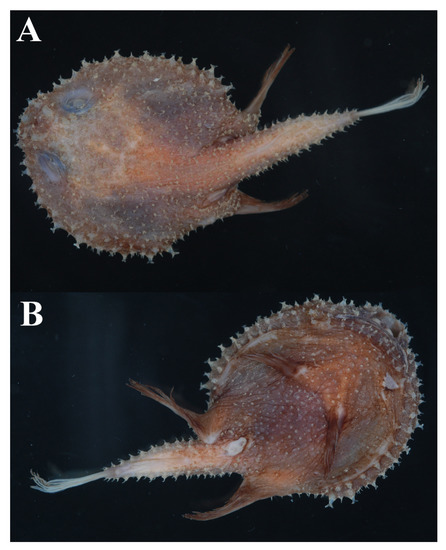
Figure 26.
Halieutopsis oblonga (Smith and Radcliffe, 1912), nontype, FRIP 0516, 58.0 mm SL, southwestern Taiwan. (A). Dorsal view. (B). Ventral view.
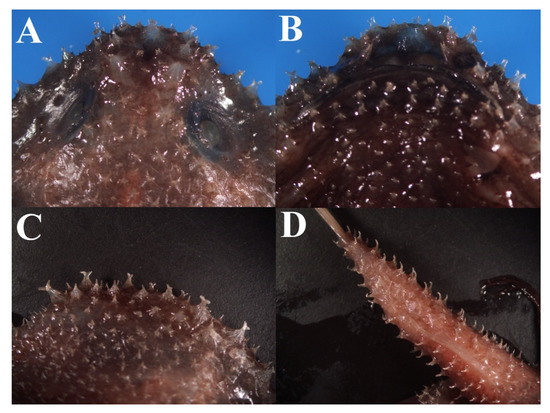
Figure 27.
Halieutopsis oblonga (Smith and Radcliffe, 1912), from FRIP 0516. (A). Dorsal view of front head. (B). Ventral view of front head. (C). Dorsal view of left disk margin, with arrow pointing to subopercular tubercle. (D). Ventral view of tail.
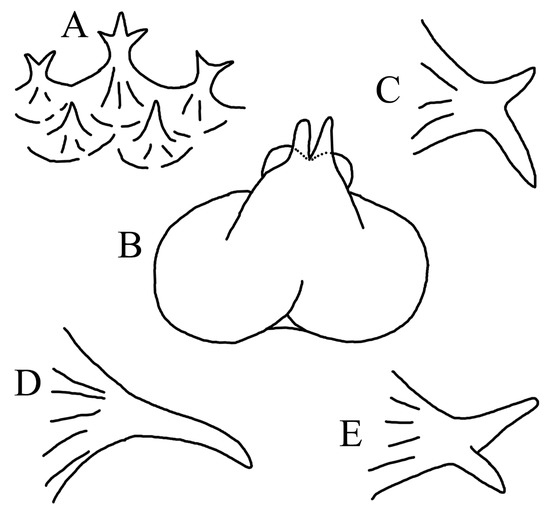
Figure 28.
Esca and squamation of H. oblonga (Smith and Radcliffe, 1912), FRIP 0516, 58.0 mm SL. (A). Rostral tubercles. (B). Esca. (C). Tubercle on disk margin. (D). Tubercle on tail. (E). Subopercular tubercle.
Synonymy. Coelophrys oblonga Smith & Radcliffe [5]: 214 (holotype; USNM 144223, Sulawesi) (Figure 25). Bradbury [6]: 411 (considered valid, but possibly in Dibranchus). Bradbury [2]: 2 (Checklist).
Specimens examined. Holotype (Figure 25). USNM 144223 (47.5, dried out), Albatross Philippine Expedition, 1907-1910, Albatross sta.5656, 3°17′39.8″ S, 120°36′43.2″ E, Gulf of Boni, Olang Point, Sulawesi, 885 m, 12 foot Agassiz beam trawl, 19 December 1909.
Non-types. Japan: BSKU 76568 (1, 32.1), R/V Hakuho-maru, cr. KH-73-2, st. 4, 27°06.8′ N, 128°41.9′ E, off Yoron Island, 3 m beam trawl, 870–945 m, 24 February 1973. Taiwan: FRIP 0516 (1, 58.0), 22°01.5′ N, 120°09.1′ E, South China Sea, 30 July 2000 (Figure 26, Figure 27 and Figure 28). Indonesia: ZMA 123.864 (1, 55.1), Siboga sta. 208, 5°39′ S, 122°12′ E, Banda Sea, 1886 m; ZMA 123.865 (1, 46.1), Siboga sta. 85, 0°36.5′ S, 119°29.5′ E, Macassar Strait, 724 m; ZMA 101.876 (1, 28.4), Siboga sta. 211, 5°40′ S, 120°45′ E, Banda Sea, 1158 m. Solomon Islands: MNHN 2002-3701 (1, 28.7), salomon 1, n.o. alis, sta. cp1753, 9°2′6″ S, 159°49′4.8″ E, 1001–1012 m, 26 September 2001. Vanuatu: MNHN 1997-4038 (1, 36.8), musorstom 8, n.o. alis, sta. cp1126, 15°58′1.2″ S, 166°40′1.2″ E, 1210–1260 m, Coral Sea, 10 October 1994; MNHN 1997-4107 (1, 63.3), musorstom 8, sta. cp1037, 18°3′0″ S, 168°54′0″ E, 1058–1086 m, 29 September 1994. Indonesia: BSKU 16701 (1), R/V Hakuho-maru, cr. KH-72-1, st. 26., 9°27.0′ S, 127°58.6′ E, Timor Sea, beam trawl, 690–850 m, 18–19 June 1972.
Diagnosis. Rostrum consists of five enlarged tubercles, including trifid tubercle at tip flanked by two pairs of bifurcate tubercles on anterior edge of rostrum. Tubercles on dorsal surface simple, with 5–6 facets; simple tubercles also present on ventral surface. Dorsal lobe of esca very low, with pair of cirri in front and pair of flaps in back. Tubercles on tail all simple.
Description. Disk elliptical to subtriangular, slightly shorter than wide (Figure 26A), tail slender, tapering to caudal fin. Head depressed, with cranium somewhat elevated above surface of disk. Rostrum a short, broad shelf consisting of five enlarged tubercles and several smaller ones. Tubercle on rostrum tip trifid, directed upwards, flanked by two pairs of bifurcate tubercles on anterior edge (Figure 27A and Figure 28A). Illicial cavity wide, its opening wider than high, barely visible in ventral view.
Esca totally housed within illicial cavity, with three lobes: Dorsal lobe with pair of cirri in front and pair of flaps in back, and two enlarged, rounded ventral lobes (Figure 28B). Eyes relatively small (11.4–13.3% SL), oval, directed laterally and upwards. Mouth moderate wide (21.5–29.3% SL), slightly concave, with upper jaw overlying lower jaw; shallow concavity present between premaxillae. Villiform teeth arranged in narrow bands in jaws, those of upper jaw not visible when mouth closed; no teeth on palate and vomer; two small, well-separated patches of teeth on ceratobranchial V (tongue).
Principal tubercles present on entire body except for gill openings, eyes, illicial cavity, and fins, with no small spinules between then. Those on dorsal surface small and simple, usually with 5–6 facets and very densely arranged, those on disk margin bifurcate at tip (Figure 28C), those on subopercle also bifurcate (Figure 28E), and those on ventral side simple and densely placed. Tubercles on tail simple (Figure 28D), forming four rows on dorsal surface, two rows on each side associated with lateral line, and two rows on ventral surface. Lateral-line neuromasts: SS 6, PMS 0, CS 8, BS 8–9, SOS 5–6, POS 2–4, DBSS 3–4, PBSS 3, vs. 3–5, TS 8–10 (mainly 9) (Table 1 and Table 2).
Distribution. Uncommon and apparently restricted to the Western Pacific off Japan, Taiwan, Indonesia, Philippines, Solomon Islands, and Vanuatu (Figure 3). Bathymetric range 690–1886 m.
Remarks. This species was previously placed in Coelophrys by Smith and Radcliffe [5] and Bradbury [2]. The holotype has dried out and is in bad condition. Nonetheless, the holotype and the other examined specimens commonly possess a relatively flat body disk, normal-sized pelvic fins, relatively long tail, narrow frontal bone, shallow illicial cavity, and esca free from the skin of the illicial cavity, indicating this is a valid and recognizable species of Halieutopsis. This species shows quite a broad bathymetric range, and more specimens are required to understand the depth range of their distributions.
3.1.14. Halieutopsis okamurai sp. nov.
(Okamura’s deepsea batfish)
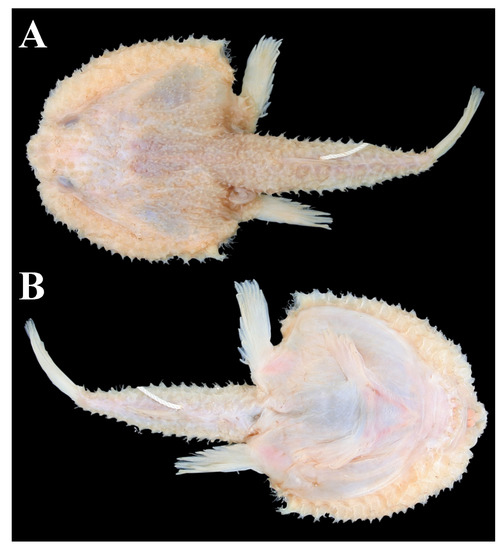
Figure 29.
Halieutopsis okamurai sp. nov., holotype, BSKU 19899, 65.0 mm SL. (A). Dorsal view. (B). Ventral view.
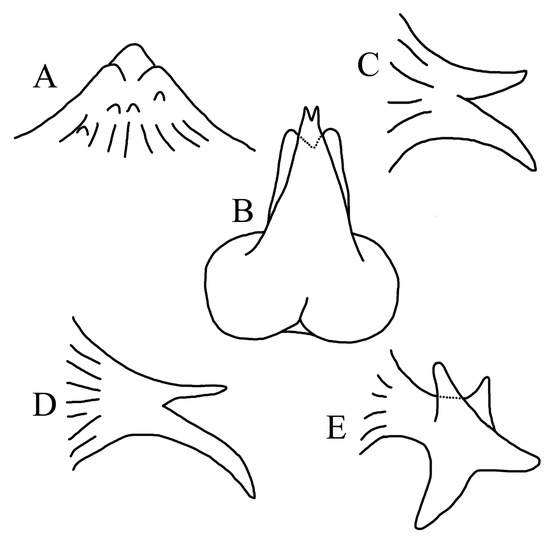
Figure 30.
Esca and squamation of H. okamurai sp. nov., from holotype. (A). Rostral tubercles. (B). Esca. (C). Tubercle on disk margin. (D). Tubercle on tail. (E). Subopercular tubercle.
Zoobank: urn:lsid:zoobank.org:act:35C0C621-9CA5-4059-BD59-8CAAD66FEF6B
Holotype (Figure 29 and Figure 30). BSKU 19899 (male, 65.0), R/V Soyo-Maru, st. B5, 30°39.4′ N, 140°36.8′ E, Ogasawara Islands, Japan, northwestern Pacific, 1950 m, 3 December 1968, coll. O. Okamura.
Etymology. This species is named after the late Dr. Osamu Okamura (Professor Emeritus, BSKU), who collected the specimen, in recognition of his remarkable contributions to the study of deep-sea fishes, especially the gadiform fishes.
Diagnosis. Dorsal surface of disk and tail covered with moderate-sized tubercles and exhibiting following combination of features: Tubercle on rostrum small and low, bearing some small spinules at its base; simple tubercles on disk edge forming serrated margin; ventral surface naked except for two tubercles on each side of pelvic fin bases; tubercles on tail associated with lateral-line neuromasts bifurcate; one or two lateral-line neuromasts on each side of ventral series; following proportional measurements relatively small: Skull length 27.4% SL, eye diameter 7.1% SL, illicial cavity width 8.8% SL, mouth width 19.4% SL, upper jaw length 10.6% SL, predorsal length 62.2% SL, postanal length 51.7% SL, preanal length 70.0% SL, dorsal-fin length 14.6% SL, pectoral-fin length 20.0% SL, anal-fin length 14.2% SL, caudal-fin length 17.1% SL.
Description. Proportional measurements and meristics of holotype as given in Table 1, Table 2 and Table 8.
Body disk depressed; head rather elevated above surface of disk; disk oval, longer than wide, with somewhat truncated anterior margin, (Figure 29A); disk relative short and narrow as reflected in proportions of skull length, head depth, disk margin, and preanal length. Rostrum a small, triangular shelf, slightly overhanging mouth and slightly inclined downwards anteriorly; tubercle on rostrum low and blunt, bearing some small spinules at its base (Figure 30A). Illicial cavity slightly depressed, its opening wider than high, barely visible in ventral view. Dorsal lobe of esca large and leaf-like, bearing two small cirri on its tip and two flaps behind (Figure 30B). Eyes smallest among the congeners, its diameter 7.1% SL.
Villiform teeth in narrow bands in jaws, not visible in upper jaw when mouth closed. Pelvic fins small, with relatively thick skin. Principal tubercles on dorsal surface moderate in size, with 5–6 facets, those on disk margin forked (Figure 30C), those on subopercle divided into 4 short spinelets (Figure 30E). Tubercles absent from ventral surface except for 2–3 small ones at each side of pelvic fin bases; those on dorsal and ventral surfaces of tail all simple and densely placed, but those associated with lateral-line scales of tail bifurcate (Figure 30D). Lateral-line neuromasts: SS 6, PMS 1, BS 8, SOS 5, DBSS 3, PBSS 3, vs. 1/2, TS 10/11.
Coloration. Uniformly creamy white in preservative; fresh color unknown.
Distribution. Represented only by the holotype collected between Japan’s outlying Izu and Ogasawara Islands, northwestern Pacific, at a depth of 1950 m.
Comparison. This species can be distinguished easily from all of its congeners by its squamation and proportions. The naked belly and the two tubercles at each side of the pelvic fin base indicate an affinity with H. tumifrons from the Eastern Tropical Pacific and H. bathyoreos and H. nudiventer from the Indo-West Pacific.
It is most similar to H. tumifrons: Both species have a short rostrum, small eyes, bifurcate tubercles associated with the lateral-line neuromasts on the tail, and tubercles on the disk edge composed of 2–3 fused simple spines that are not bifurcate at the tip. It differs from H. tumifrons in having a slightly projecting rostrum (vs. one overlying the mouth) and dense tubercles on the dorsal and ventral surfaces and tail (vs. loosely scattered on the dorsal surface and absent from the ventral surface of the tail). It differs from H. nudiventer in having tubercles with 5–6 facets on the dorsal surface (vs. 10–14 facets), numerous densely placed, moderate-sized tubercles on the dorsal surface and tail (vs. loosely scattered, large tubercles on the dorsal surface and no tubercles on the ventral surface of the tail), and bifurcate tubercles on the tail associated with the lateral-line scales (vs. simple tubercles there).
It differs from H. bathyoreos in that the rostrum does not extend out and overhang the mouth, the illicial cavity is a depressed hollow (vs. a broad, flat trough) that is barely visible in ventral view (vs. wholly visible), the tubercles on the disk edge and tail are small and densely placed (vs. larger and more loosely scattered), and the tubercles associated with the lateral-line neuromast on the tail are bifurcate (vs. simple).
3.1.15. Halieutopsis simula (Smith & Radcliffe, 1912)
(Fluffy-esca deepsea batfish)
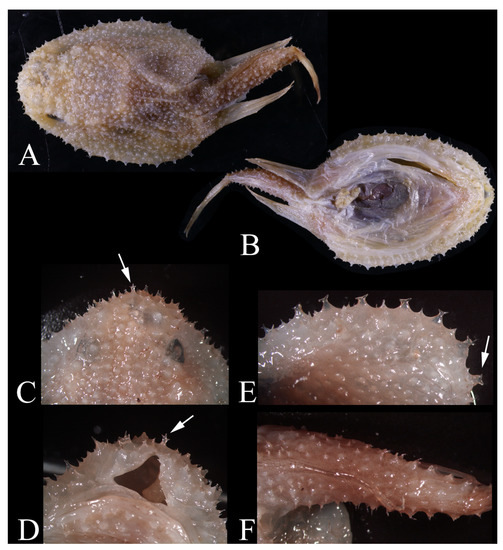
Figure 31.
Halieutopsis simula (Smith and Radcliffe, 1912). (A,B). ASIZP 57202, 67.1 mm SL, Taiwan, photos by C.-N. Tang. (C–F). AMS I.22809-049, 41.2 mm SL, Northwest Shelf, Australia. (A). Dorsal view. (B). Ventral view. (C). Dorsal view of head, with arrow pointing to rostral tubercle. (D). Ventral view of rostrum, with arrow pointing to rostral tubercle. (E). Disk margin, with arrow pointing to subopercular tubercle. (F). Dorsal view of tail.
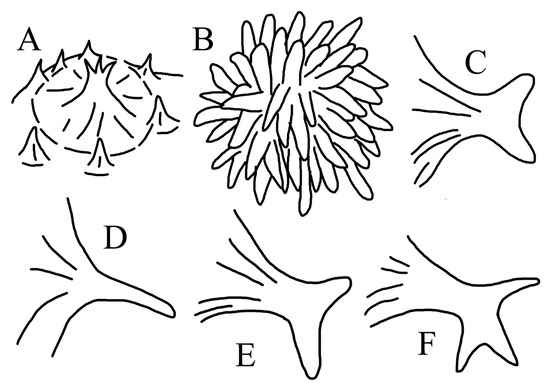
Figure 32.
Esca and squamation of H. simula (Smith and Radcliffe, 1912). (A). Rostrum. (B). Esca. (C). Tubercle on disk margin. (D). Tubercle on tail. (E,F). Subopercular tubercles. (A–E). AMS I.22816-022, 61.5 mm SL. F. AMS I.22809-049, 41.2 mm SL.
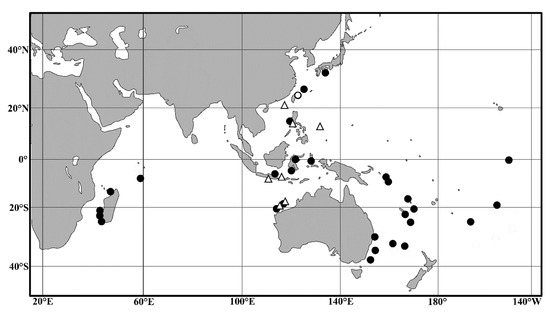
Figure 33.
Distribution map of H. simula (open triangles), H. stellifera (black dots), and H. taiwanea sp. nov. (open circle). One dot may represent more than one capture.

Table 9.
Morphometric and meristic data of H. simula and H. stellifera. * Data taken from Bradbury (1988). HT = Holotype, NT = Nontype(s).
Synonymy. Dibranchus simulus Smith & Radcliffe [6]: 211 (type locality: Philippines).
Dibranchus infranudus de Beaufort in Weber & de Beaufort [26]: 228 (type locality: Flores Sea).
Halieutopsis simula (Smith & Radcliffe [5]): Bradbury [8]: 14; Bradbury [16]: 2025. Bradbury in Randall & Lim [17]: 598 (checklist). Bradbury [2]: 7 (checklist). Shao et al. [27]: 243 (New record for Taiwan). Ho & Shao [4]: 295 (brief description).
Halieutopsis simulus (Smith & Radcliffe [5]): Bradbury [6]: 412 (new combination). Okamura et al. [28]: 204 (mentioned).
Specimens examined. Holotypes. Dibranchus simulus: USNM 70274 (64.0), Albatross Philippine Expedition, 1907-1910, Albatross sta.D5283, 13°48′29.9″ N, 120°28′40.8″ E, off Malavatuan Island, south of Luzon, Philippines, 512 m, 18 July 1908. Dibranchus infranudus: ZMA 101.877 (58.2), 7°35.4′ S, 117°28.6′ E, off Pulau Salius Kecll, Flores Sea, Indonesia, 521 m. Non-types. Taiwan: ASIZP 57202 (1, 67.1), Tong-sha (Pratas) Islands, South China Sea, 15 May 1993 (Figure 31). Philippines: USNM 122,675 (1, male, 47.3), Albatross Philippine Expedition 1907-1910, Albatross sta.D.5283, 13°48′30″ N, 128°28′40″ E, off Malavatuan, southern Luzon, 512 m, 18 July 1908. Western Australia: AMS I.22809-049 (1, 41.2), 18°40′ S, 116°42′ E, Northwest Shelf, 584–592 m, Engel trawl, 4 April 1982 (Figure 31); AMS I.22816-022 (1, 61.5), 18°40′ S, 116°44′ E, Northwest Shelf, 594–612 m, Engel trawl, 7 April 1982 (Figure 32); NTM S.12588-019 (1, 60.9), 17°22′ S, 118°38′ E, Northwest Shelf, 430 m, 2 November 1985, coll. W. Houston.
Diagnosis. Body disk box-like, not very depressed (Figure 31A). Eyes directed laterally, not dorsally; interorbital space very broad (19.7–22.7% SL) (Table 9). Illicial cavity with downward-directed triangular opening only visible in ventral view (Figure 31D); esca uniquely bearing mass of filaments (Figure 32B). Ventral surface of body wholly naked; tubercles on rest of body surface, including tail (Figure 32D), simple except for small, trifid principal tubercle on rostrum (Figure 31C), bifurcate tubercles on disk margin (Figure 32C), and bifurcate or trifid subopecular tubercles (these being weak, not especially enlarged compared to neighboring tubercles) (Figure 32E,F). Lateral-line neuromasts: BS 9–14, POS 3–5, DBSS 3–5, vs. 3–6 (Table 1 and Table 2).
Distribution. Known from the Western Pacific off Taiwan, the Philippines, Indonesia, and NW Australia (Figure 33); bathymetric range 430–612 m.
Remarks. Halieutopsis simula is unique in having a mass of cirri on the esca. Most specimens were originally identified as H. stellifera because the similar flabby, box-like body, and squamation. However, it is easy to recognize H. simula by its totally naked ventral surface and its larger illicial cavity compared to that of H. stellifera.
Although only a few specimens were available for this study, it is notable that most of the body and fin proportions of the smallest specimen (41.0 mm SL, AMS I.22809-049) were larger than those of the other three specimens (60.9–67.1 mm SL). A similar situation was also found in H. stellifera (see below), which may indicate that the body form undergoes a transformation at a particular growth stage, perhaps related to a change in habitat.
The relatively large predorsal length (79.6% SL) noted by Bradbury [8] appears to be a mistake (maybe it is the preanal length), because in all specimens of Halieutopsis examined in the present study, the dorsal fin starts well before the anal fin and the predorsal length is, therefore, considerably smaller than the preanal length.
3.1.16. Halieutopsis stellifera (Smith & Radcliffe, 1912)
(Starry deepsea batfish)
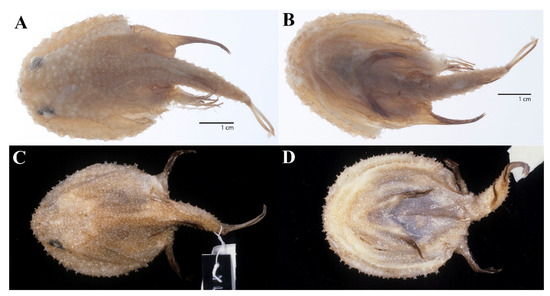
Figure 34.
Halieutopsis stellifera (Smith and Radcliffe, 1912). (A,B). Holotype, USNM 70273, 67.9 mm SL, photos by S. Raredon, courtesy of USNM. (C,D). BSKU 29775, 64.6 mm SL, photos by M. G. Bradbury. (A,C). Dorsal view. (B,D). Ventral view.
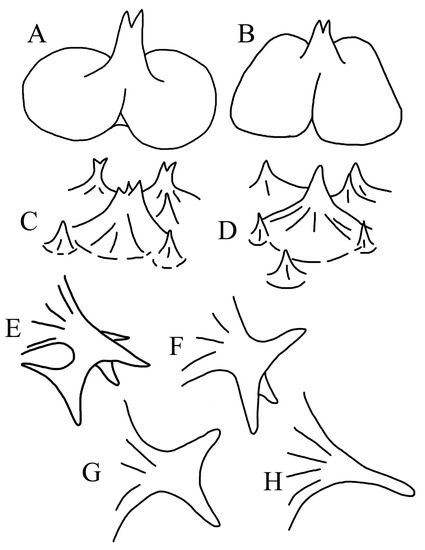
Figure 35.
Esca and squamation of Halieutopsis stellifera (Smith and Radcliffe, 1912). (A,B). Esca. (C,D). Rostrum. (E,F). Subopercular tubercle. (G). Tubercle on disk margin. (H). Tubercle on tail. (A,C,E,G). AMS I.29824-002, 103.1 mm SL. (B,D,F,H). AMS I.22817-003, 78.7 mm SL.
Dibranchus stellifer Smith & Radcliffe [5]: 210 (type locality: Flores Sea off Sulawesi).
Halieutopsis stellifera (Smith & Radcliffe [5]): Bradbury [6]: 412 (generic reassignment). Okamura et al. [28]: 201 (description). Bradbury [8]: 11 (description). Bradbury [16]: 2025 (list). Bradbury in Randall & Lim [17]: 598 (checklist). Ho & Shao [4]: 90 (brief description).
Specimens examined. Holotype (Figure 34): USNM 70273 (male, 67.9), Albatross Philippine Expedition 1907-1910, sta. D.5660, 5°36′30″ S, 120°49′ E, Cape Lassa, Flores Sea, Sulawesi, 1266 m, 12 foot Agassiz beam trawl, 20 December 1909. Non-types. Japan: BSKU 29775 (1, 64.6), Yuryo-maru, st. 5-T3, 27°00.5′ N, 125°50.5′ E, Okinawa Trough, bottom trawl, 410–420 m, coll. K. Uchida, 10 December 1979 (Figure 34); BSKU 57861 (1, 36.9), R/V Tansei-maru, cr. KT-02-03, st. E-2, 26°15′ N, 125°17′ E, off Okinawa Islands, beam trawl, 991–955 m, 26 April 2002; BSKU 44942 (1, 58.0), R/V Kotaka-maru, 33°08′57″ N, 133 °37′49″ E, Tosa Bay, otter trawl, 450–490 m, 1 August 1988; NSMT P66381 (2, 38.0–40.0), Ryukyu Is., 1000 m. The Philippines: MNHN 1986-0157 (1, 46.7), musorstom 1, sta. 49cp4, 13°49′1.2″ N, 119°58′58.8″ E, 925 m, 25 March 1976; SIO 69-19 (1, 26.2), 6°0.5′ N, 122°35.6′ E, Celebes Sea, 3000 m wire out, 21 April 1968. Indonesia: CAS 57248 (1, 24.0), 0°40′0″ S. 128°58′30″ E, Halmahera Sea, 0–1200 m; USNM 122306 (1, 57.1), Albatross Philippine Expedition 1907-1910, sta. D.5612, 0°37′59.5″ S, 121°45′39.6″ E, Buka Buka Island, Gulf of Tomini, Sulawesi, 1372 m, 20 November 1909; ZMA 115.756 (1, 49.5), Siboga sta. 45, 7°24′ S, 118°15.2′ E, 794 m, 6 April 1899. Solomon Islands: MNHN 2006-0191 (1, 41.1), salomon 2, sta. cp2267, 7°54′28.8″ S, 156°57′7.2″ E, 590–600 m, 4 November 2004; MNHN 2006-0313 (1, 77.6), salomon 2, sta. cp2276, 8°40′8.4″ S, 157°46′8.4″ E, 814–980 m, 5 November 2004; MNHN 2006-0688 (4, 57.8–76.0), salomon 2, sta. cp2213, 7°35′31.2″ S, 157°46′8.4″ E, 495–650 m, 26 October 2004. Vanuatu: MNHN 1997-4120 (4, 26.3–42.9), musorstom 8, n.o. alis, sta. cp956, 20°33′0″ S, 169°34′58.8″ E, 1175–1210 m, Coral Sea, 20 September 1994; MNHN 1997-4030 (2, 34.7–43.8), musorstom 8, n.o. alis, sta. 1076, 15°52′58.8″ S, 167°30′0″ E, Coral Sea, 1100–1191 m, 4 October 1994. New Caledonia: MNHN 1992-0346 (1, 69.0), pelagia 1, n.o. coriolis, sta. 1/18, 22°10′1.2″ S, 165°49′58.8″ E, 880 m, 29 April 1971; MNHN 2002-0211 (1, 27.3), biocal, sta. Cp61, 24°11′6″ S, 167°31′37.2″ E, 1070 m, 2 September 1985; MNHN 2003-1406 (2, 34.2–37.7), halipro 2, n.o. tangoroa, sta. bt71, 24°49′58.8″ S, 168°9′0″ E, Coral Sea, 820–1220 m, 20 November 1996; MNHN 2004-2262 (1, 41.8), 21°42′0″ S, 166°40′0″ E, 1080 m, 11 March 1993; MNHN 2005-3284, 2005-3285, 2005-3286, 2005-3287, 2005-3288, 2005-3289, 2005-3290, 2005-3291, 2005-3292 (9, 40.1–52.2), 20°53.88′ S, 158°08.28′ W, 1027–1086 m, 23 April 2002; MNHN 2005-3298 (1, 48.1), 19°39.8′ S, 158°55.53′ W, 864–902 m, 19 April 2002. Eastern Australia: AMS I.29753-006 (1, 65.6), 31°50′ S, 153°16′ E, east of Crowdy Head, New South Wales, 878–933 m, bottom trawl, 16 August 1989; AMS I.29824-002 (1, 103.1), 34°48′ S, 151°14′ E, off Gerringong, New South Wales, 732–786 m, bottom trawl, 4 July 1989 (Figure 35); AMS I.20651-013 (1, 44.7), 27°55′ S, 154°03′ E, northeast of Danger Point, New South Wales, 548 m, bottom trawl, 6 November 1978; CSIRO H 6056-06 (1, 40.7), 33°36′ S, 166°52′ E, west of Norfolk Ridge, Tasman Sea, 1042 m; CSIRO H 6038-27 (1, 52.3) and CSIRO H 6038-28 (2, 57.8–58.8), 32°25′ S, 161°44′ E, Lord Howe Rise, Tasman Sea, 1197 m. Western Australia: AMS I.22809-012 (19, 33.8–66.3), 18°40′ S, 116°42′ E, Northwest Shelf, 584–592 m, 4 April 1982; AMS I.22816-004 (2, 29.7–49.5), 18°40′ S, 116°44′ E, Northwest Shelf, 594–612 m, 7 April 1982; AMS I.22817-003 (2, 71.0–87.0), 18°06′ S, 117°45′ E, Northwest Shelf, 492–520 m, 10 April 1982 (Figure 35); AMS I.22827-005 (3, 46.3–66.8) and ASIZP 70323 (2, 52.0–61.0), 18°41′ S, 116°46′ E, Northwest Shelf, 506–508 m, 13 April 1982; CSIRO CA3551 (1, 68.2), 17°24′ S, 118°52′ E, off Port Hedland, 458 m, 1983; CSIRO B3295 (4 of 5, 49.5–63.8), 18°07′ S, 118°09′ E, southwest of Imperieuse Reef, Northwest Shelf, prawn trawl, 400–404 m, 5 February 1983; CSIRO H 3157-04 (1, 97.1), 18°49′ S, 116°03′ E, north of Dampier Archipelago, 550 m; CSIRO H 3145-29 (1, 51.5), 17°52′ S, 118°16′ E, Rowley Shoals area, 550 m; CSIRO H 3158-04 (3, 51.5–54.4), 18°52′ S, 116°00′ E, north of Dampier Archipelago, 550 m; CSIRO H 3145-30 (3, 40.6–55.8), 17°52′ S, 118°16′ E, Rowley Shoals area, 550 m; CSIRO H 3158-03 (1, 60.4). 18°52′ S, 116°00′ E, north of Dampier Archipelago, 550 m; CSIRO H 6430-02 (1, 60.9), northeast of Rowley Shoals, 16°35′ S, 119°43′ E, 585 m, 2006; CSIRO H 7140-05 (1, 56.6), northwest of Cape Leveque, Northwest Shelf, 16°12′ S, 120°29′ E, 395–396 m, 7 June 2004; NTM S.12610-012 (1, 66.1), 17°52′ S, 118°28′ E, off Rowley Shoals, Northwest Shelf, 415 m, 7 November 1985, coll. W. Houston; NTM S.12614-004 (1, 45.9), 17°39′ S, 118°38′ E, off Rowley Shoals, 410 m, 7 November 1985, coll. W. Houston; NTM S.13115-018 (1, 37.3), 14°07′ S, 122°06′ E, north of Cape Leveque, 423 m, 25 January 1990, coll. D. Evans. Madagascar: MNHN 1986-0023, 1986-0024, 1986-0025, 1986-0026 (4, 62.3–76.5), n.o. vauban, sat. ch143, 13°45′7.2″ S, 47°38′2.4″ E, 437–700 m, 28 Feb, 1975; MNHN 1986-0029 (1, 59.1), n.o. vauban, sat. ch104, 22°15′7.2″ S, 43°1′4.8″ E, 750–810 m, 29 November 1973; MNHN 1986-0030 (1, dried out), n.o. vauban, sat. ch096, 22°21′3.6″ S, 43°3′7.2″ E, 480–500 m, 27 November 1973; MNHN 1986-0039 (1, 66.2), n.o. vauban, sat. 56tu, 23°36′0″ S, 43°31′4.8″ E, 395–410 m, 26 February 1973; MNHN 1986-0046, 1986-0047 (2, 70.1–72.2), n.o. fao60, sta. 73/060, 21°18′0″ S, 43°21′0″ E, 490–530 m, 6 June 1973; MNHN 1986-0118, 1986-0119 (2, 79.8–85.3), n.o. vauban, sat. ch097, 22°25′1.2″ S, 43°4′4.8″ E, 550–555 m, 27 November 1973. Western Indian Ocean: ZMMU P15809 (9, 34.8–41.2), 8°39′ S, 59°53′ E, 600–660 m, 25 September 1977. Line Islands: SIO 72-165 (1, 16.5), R/V Melville, 0°10.6′ S, 155°0.5′ W, 3000 m wire out, 15 July 1972.
Diagnosis. Body disk oval, box-like and less depressed (Figure 34), relatively flabby. Interorbital space broad (14.0–20.6% SL, mean 17.5%) (Table 9). All fins gray to black but becoming paler with increased body size. Rostrum rather blunt, well overhanging mouth, with small, simple to trifid tubercles (Figure 35C, D). Esca with three lobes: Two rounded and well-separated ventral lobes and leaf-like dorsal lobe with pair of cirri at tip (Figure 35A,B). Ventral surface covered with simple tubercles, those on disk margin bifurcate (Figure 35G), those on tail simple (Figure 35H), with small tubercles interspersed among larger ones; subopercular tubercles weakly developed, only slightly enlarged, divided into 3–5 small spines (Figure 35E,F).
Comparison. The species is easy to confuse with members of Coelophrys because the caudal peduncles are somewhat short in those small specimens. However, members of Coelophrys have extremely reduced pelvic fins whereas the present species has normal pelvic fins. Another character to diagnose the species is the esca is free from illicial cavity. Halieutopsis stellifera is also similar to H. nasuta but differs in having a less depressed disk, usually all fins gray to black in color and just one pair of cirri on the dorsal lobe of the esca (vs. two pairs).
Distribution. Widespread in Indo-west Pacific off Japan, the Philippines, Indonesia, Solomon Islands, New Caledonia, Vanuatu, Australia, and Madagascar, and in western Indian Ocean. Depth range 410–1372 m, with most specimens were taken from depths less than 1000 m.
Remarks. Examination of a large number of specimens revealed some morphological changes with growth. The number of teeth is initially large, and they occupy the inner two-thirds of each jaw, but they gradually decrease in size and number, eventually occupying only the inner one-third areas of each jaw. The juveniles have a relatively short tail, which becomes more slender in larger fish. The pectoral, pelvic, anal, and caudal fins have broad, black margins in juveniles and small adults; this coloration is retained in some larger adults while the others develop clear fins.
3.1.17. Halieutopsis taiwanea sp. nov.
(Taiwan deepsea batfish)
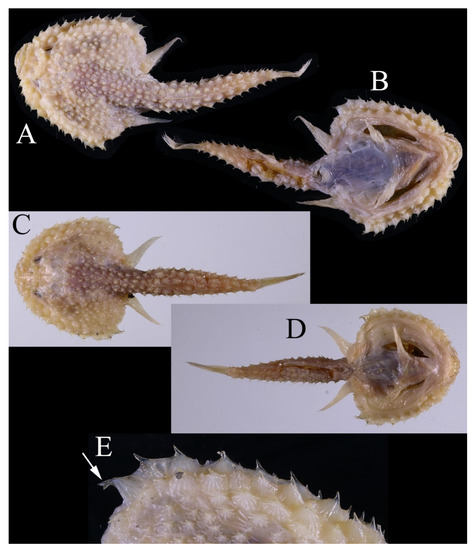
Figure 36.
Halieutopsis taiwanea sp. nov., (A,B). Holotype, ASIZP 66325, 78.3 mm SL. (C–E). Paratype, ASIZP 63324, 70.1 mm SL.
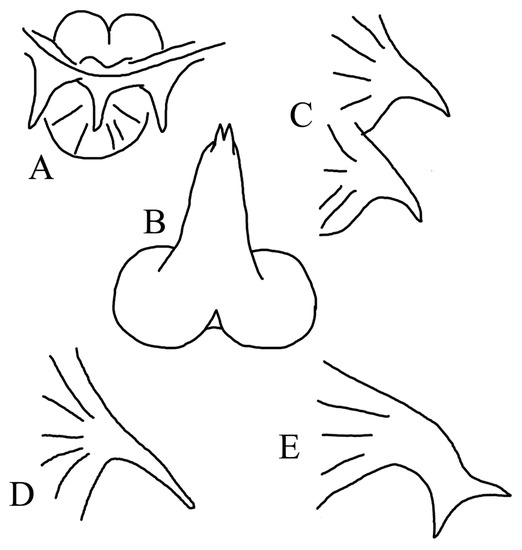
Figure 37.
Esca and squamation of H. taiwanea sp. nov., from holotype. (A). Rostrum. (B). Esca. (C). Tubercles on disk margin. (D). Tubercle on tail. (E). Subopercular tubercle.
Zoobank: urn:lsid:zoobank.org:act:1F72276F-E7DC-4C3C-B758-7730D1C51329
Halieutopsis ingerorum (not of Bradbury [8]): Ho & Shao [4]: 294 (misidentification).
Holotype (Figure 36 and Figure 37). ASIZP 66325 (78.3), Ocean Researcher I, sta. CP285, 24°16′12″ N, 122°11′24″ E, off Yilan, northeastern Taiwan, northwestern Pacific Ocean, 2246–2356 m, otter trawl, 16 June 2005.
Paratypes. ASIZP 66275 (1, 67.5), ASIZP 66324 (1, 70.0), collected in same haul as holotype (Figure 36).
Etymology. The specific name, an adjective, is based on the type locality off Taiwan.
Diagnosis. Distinguished from most congeneric species in having a strongly upturned face, very short, upwards-directed rostrum and small mouth and jaw, but separable in particular from the most similar species H. ingerorum by its relatively smaller skull (22.6–22.8% SL), relatively shorter disk margin (35.6–28.1% SL), relatively smaller mouth (13.5–15.3% SL), upper jaw length (9.3–10.6% SL), predorsal length (55.9–58.4% SL), pre-anus length (49.9–55.4% SL) and preanal length (66.6–69.5% SL), and its relatively longer tail (44.6–50.1% SL).
Description. Morphometric and meristic data as given in Table 1, Table 2 and Table 5. Body disk depressed, with skull slightly elevated above surface of disk. Disk sub-triangular, with length subequal to width and anterior margin somewhat truncate (Figure 36). Disk relatively short and narrow as reflected in proportions of skull length, head depth, head width, disk margin, predorsal and preanal lengths.
Face strongly upturned (Figure 36A,C), with very short, upwardly tipped rostrum set back to anterior margin of eyes; tubercle on rostrum low and blunt, forming trident with pair of flanking tubercles (Figure 37A). Illicial cavity part of large, shallow, naked concavity on upper surface of snout, its opening wider than high. Dorsal lobe of esca slender, tongue-like, bearing two small cirri on tip and no posterior or lateral flaps (Figure 37B). Eyes very small (4.9–6.2% SL). Mouth small (13.5–15.3% SL) with villiform teeth in broad bands on jaws, relatively loosely scattered on upper jaw and not visible there when mouth closed. Pelvic fins small, with relatively thick skin.
Principal tubercles on dorsal surface of moderate size with 10–16 facets (mostly 13–14); those on disk margin slightly flattened with bases closely adjoining each other to form serrate margin, all spines simple-tipped (Figure 37C); tubercles absent from ventral surface including pelvic-fin base; that on subopercle curving slightly inwards (Figure 36E), divided into two short, upwardly directed spinelets at its base (Figure 37E), with one additional small, upwardly directed spinelet present in ASIZP 66275. Tubercles on dorsal and ventral surfaces of tail simple with broad base; those associated with lateral-line scales on sides of tail simple, directed outwards and backward (Figure 37D).
Lateral-line neuromasts: SS 3, PMS 0, CS 8, BS 9, SOS 5, POS 2, DBSS 3, PBSS 3, vs. 1–2, TS 14.
Coloration. Freshly caught specimens milky white and somewhat pinkish; nostrils red (possibly due to injury in trawl). Preserved specimens uniformly creamy white to slightly yellowish (Figure 36).
Distribution. Known only from type series collected off northeastern Taiwan (Figure 33); depth range 2246–2356 m.
Remarks. The three type specimens from off Taiwan were initially reported as H. ingerorum by Ho and Shao [4]. Compared to the holotype and two additional specimens of that species from the western Indian Ocean, the three specimens of H. taiwanea have very different body proportions (see Diagnosis and Table 5). Moreover, the present three type specimens were collected at depths of 2246–2356 m, much deeper than the three specimens of H. ingerorum (1300–1600 m).
3.1.18. Halieutopsis tumifrons Garman, 1899
(Truncate-snout deepsea batfish)
Halieutopsis tumifrons Garman [1]: 90 (Type locality: Galápagos Islands). Bradbury [6]: 412 (review of genera). Bradbury [8]: 15 (review). Bradbury [2]: 7 (checklist).
Specimens examined. Lectotype: MCZ 28729 (male, 69.0), eastern tropical Pacific near Galápagos archipelago, 00°36′ S, 86°46′ W, 2418 m. Paralectotype: MCZ 28730 (1, male, 64.0), Albatross sta. 3413, 2°34′ N, 92°06′ W, 2487 m, 5 April 1890.
Diagnosis. Body disk strongly depressed, subquadrangular, markedly indented anteriorly. Ventral surface of disk naked except for lateral-line scales on either side of anus. Rostrum very short, overlying mouth but only extending to anterior margin of disk. Eye diameter very small, 7.3–7.7% SL; interorbital space narrow, 11.3–12.5% SL. Esca with two rounded ventral lobes and thin, elongated median dorsal lobe with two distal cirri. Membrane between pectoral pedicles and body reduced, and pectorals strongly elbowed.
Distribution. Known only from two syntypes from vicinity of Galápagos Islands at depths of 2418–2487 m.
Remarks. See Bradbury [8] for detailed description and figures. The naked ventral side with only two tubercles on each pelvic fin base suggests that this species is closely related to Halieutopsis nudiventer, H. bathyoreos, H. ingerorum, H. okamurai, and H. taiwanea. Halieutopsis tumifrons is the only member of the genus that occurs in the Eastern Pacific. The anterior margin of its disk is unique in having an indented rostrum that does not overhang the mouth. For more than a century, only the two original type specimens redescribed in detail by Bradbury [8] have been known.
4. Discussion
4.1. Systematics
Halieutopsis appears to be morphologically similar to Coelophrys, Dibranchus, and Solociaguama. Among these, Halieutopsis and Coelophrys are the most difficult to distinguish because some species display diagnostic characteristics of both. Because of this, Bradbury [9] suggested that these two genera might be synonymous, but an examination of Halieutopsis has suggested that Halieutopsis and Coelophrys are two distinct genera [4,6,16].
Members of Halieutopsis can be divided into two groups by the presence or absence of tubercles on the ventral surface of the body. Eight species, viz., H. echinoderma, H. galatea, H. kawaii, H. margaretae, H. murrayi, H. nasuta, H. oblonga, and H. stellifera, have tubercles on the ventral surface. Among these species, H. kawaii and H. nasuta have fewer tubercles on the ventral surface than the others, because tubercles are mostly present on the outer regions of ventral surface and anterior to the pelvic fin bases and rather scattered or completely absent from the center of the belly.
Except for H. kawaii and H. nasuta, the other species have more complex and dense tubercles, and some with small, simple tubercles interspersed among the larger ones. Halieutopsis stellifera shows the great similarity to members of Coelophrys in body shape but is different from them in not having strongly reduced pelvic fins and esca free from the wall of the illicial cavity. Halieutopsis margaretae is the most distinct form in this group and may have a close relationship to Dibranchus and Solocisquama.
The remaining species, viz., H. simula, H. ingerorum, H. andriashevi, H. taiwanea, H. tumifrons, H. bathyoreos, H. nudiventer, and H. okamurai, have no tubercles on the ventral surface except as noted below (i.e., few on pelvic-fin base). Furthermore, there are usually no small tubercles interspersed among the larger one. Most of these species have bifurcate tubercles on disk margin, but three species, H. andriashevi, H. okamurai, and H. tumifrons, have a continuous, saw-toothed marginal ridge consisting of compound disk-edge tubercles, each of which is formed from 2–3 simple tubercles.
The common presence of 2–3 pairs of simple tubercles on the pelvic-fin base may indicate a close relationship among H. bathyoreos, H. nudiventer, H. tumifrons, and H. okamurai. Among them, H. bathyoreos and H. nudiventer, and also H. tumifrons and H. okamurai, represent the most similar species pairs.
Despite having a completely naked ventral surface, H. simula resembles H. stellifera (with dense tubercles on ventral surface) and both appear to represent a species pair based on their more-or-less box-like body disk.
Halieutopsis tumifrons has a very distinct distribution range, being the only member of the genus found in the Eastern Pacific, and H. andriashevi represents the deepest record (about 4000 m) for the genus as well as the family (<3000 m in congeners and <2000 m in other ogcocephalids). Although Bradbury [8] suggested that H. tumifrons is the most derived form in the genus, both H. tumifrons and H. andriashevi appear to be equally highly derived and may have evolved independently. The saw-toothed scales seem not to be associated with the forming of bucklers [29].
4.2. Biogeographic Distributions
Halieutopsis has a wide geographic distribution in the Indo-West Pacific region, except for H. tumifrons, the only species of the genus found in the Eastern Pacific (off the Galápagos Islands). Sister species have particularly wide distribution ranges. Halieutopsis nasuta, a narrowly tropical species, is found from the eastern Indian Ocean to the Western Pacific between 22° N and 15° S. Halieutopsis stellifera and H. oblonga are widespread in the Indo-West Pacific between 35° N and 35° S, as are H. nudiventer and H. bathyoreos; both commonly occur in the Equatorial Pacific and Indian Ocean. Halieutopsis margaretae has been found in the Western Pacific and Hawaii.
In contrast, the known geographic ranges of the following eight species are somewhat restricted: Halieutopsis andriashevi, H. galatea, and H. ingeroum are only founded in the Indian Ocean, H. murrayi in the Gulf of Aden, H. okamurai off eastern Japan in northwestern Pacific (Figure 3), H. taiwanea off northeastern Taiwan (Figure 33), H. echinoderma off Taiwan and eastern Australia (Figure 3), and H. simula in the western Central Pacific and on the Northwest Shelf of Australia (Figure 33). The disjunctive distributions of the latter two species may be artifacts of sampling effort, and further investigations may reveal their occurrence in intervening regions.
The two species known from Hawaii, H. bathyoreos (Figure 6) and H. margaretae (Figure 17), can also be found in the margins of the Pacific Plate, which implies a distributional pattern that has been called the “Hawaiian Exception” proposed by Springer [30].
Most species were collected at depths of 300–1200 m. The deepest record was 3800–4020 m for Halieutopsis andriashevi, followed by H. tumifrons at 2418–2487 m, and H. taiwanea at 2246–2356 m. Halieutopsis okamurai collected from 1950 m depth, was the second deepest among the northwestern Pacific species. A number of the more shallowly occurring species were still eurybathic, exhibiting wide depth ranges: H. bathyoreos at 380–1760 m, though mainly deeper than 1000 m; H. nudiventer at 430–1690 m, though mainly between 800 m and 1300 m; H. nasuta at 297–1141 m, though mainly between 300 m and 600 m; and H. margaretae at 445–1185 m. Halieutopsis echinoderma was exceptionally stenobathic, occurring only at depths of 400–511 m.
The distributional ranges of H. nudiventer and H. nasuta are similar, but their depths of occurrence are quite different, mainly 800–1300 m and 300–600 m, respectively. The same situation also can be found in the partly sympatric H. margaretae and H. bathyoreos, taken mainly from 445–1185 m and 1040–1530 m, respectively. Bradbury [9] mentioned two sympatric Atlantic species of batfish, Dibranchus atlanticus Peters [31] and D. tremendus Bradbury [9], with their respective bathymetric ranges split at ca. 1500 m. These examples may indicate that the mentioned congeners use different resources from different depths in the same geographic region.
Funding
This study was partially supported by the Ministry of Science and Technology, Taiwan (formerly National Science Council); the National Museum of Marine Biology & Aquarium, Taiwan; the California Academy of Sciences, San Francisco (Lakeside Foundation); the Museum of Comparative Zoology, Cambridge (Ernst Mayr Grant); the Smithsonian Institution, National Museum of Natural History, Washington D.C. (Visiting Student Fellowship); the American Museum of Natural History, New York (Lerner-Gray Grant); and the Field Museum of Natural History, Chicago (Visiting scholarship).
Institutional Review Board Statement
Not applicable.
Informed Consent Statement
Not applicable.
Data Availability Statement
Not applicable.
Acknowledgments
This study is dedicated to the late Margaret G. Bradbury (1927–2010), in recognition of her enormous contribution to our knowledge of batfishes. She selflessly offered all of her information, photographs, and data to the author, as well as her warm friendship. Many thanks go to M. J. Grygier (NMMBA) and B. Mundy and T. Munrow (NOAA) who provided a pre-submission English check of the manuscript along with other valuable comments. I am grateful to the following people for loaning specimens or providing various help during my visits to their museums: J. Sparks, B. Brown, R. Arrindell, P. Chakrabarty (AMNH); J. Paxton, M. McGrouther, A. Hay, S. Reader, K. Graham (AMS); J. G. Lundberg (ANSP); O. Crimmen, P. Campbell, J. Caclaine (BMNH); J. E. Randall, A. Suzumoto (BPBM); H. Endo, N. Nakayama, E. Katayama (BSKU); T. Iwamoto, W. Ecshmeyer, D. Catania, M. Huang, J. Fong (CAS), P. Last, A. Greham, W. White, C. Ferraris, J. Pogonoski (CSIRO), T. Nakabo, Y. Kai (FAKU); L. Smith, M. A. Roger (FMNH); K. Amaoka, K. Nakaya, M. Yabe, H. Imamura, T. Kawai, T. Kaga, F. Tashiro (HUMZ); N. V. Parin, A. Prokofiev, S. A. Evseenko (IOAN); H. Motomura (KAUM); R. Feeney, J. Seigel (LACM); K, Liem, K. Hartel (MCZ); G. Duhamel, P. Pruvost, R. Causse, Z. Gabsi, B. Séret, (MNHM); C. Roberts, A. Stewart, C. Struthers (NMNZ); M. Gomon, D. Bray (NMV); K. Matsuura, G. Shinohara, K. Kuriiwa, M. Nakae, T. Takata, T. P. Satoh (NSMT); H. Larsen, B. Russell, G. Dally, M. Hammeu (NTM); J. Johnson (QM); E. Heemtra, W. Holleman, O. Gon, E. Anderson (SAIAB); H. J. Walker, C. Kelpadlo (SIO); L. Page, G. Burgess, R. Robins (UF) L. Parenti, J.-K. Song, R. Vari, V. Springer, J. Williams, T. Munroe, D. Smith, D. Johnson, S. Raredon, J. Clayton, S. Smith (USNM); S. Morrison (WAM); A.V. Balushkin (ZIN); R. Vonk (ZMA); P. Bartsch, K. Claeson (ZMB); E. D. Vasil′ Eva (ZMMU); J. Nielsen, P. Møller, T. Menne (ZMUC); K. Sakamoto (ZUMT). Radiography was performed by S. Raredon (USNM). Special thanks go to T. Pietsch (UW) and K.-T. Shao (ASIZP) for his encouragement and provision of funding to the author. I thank H. Endo, N. Nakayama, G. Shinohara, and M. Nakae for checking the specimen data and making valuable suggestions, N. Miljkovic for translating German-language literature, and H.-H. Li and S.-L. Ng for various help.
Conflicts of Interest
The author declares no conflict of interest.
References
- Garman, S. The Fishes. In Reports on an Exploration off the West Coasts of Mexico, Central and South America, and off the Galapagos Islands by the U.S. Fish Commission Steamer “Albatross,” during 1891. No. XXVI. Bull. Mus. Comp. Zool. 1899, 24, 1–431. [Google Scholar]
- Bradbury, M.G. Family Ogcocephalidae Jordan 1895–batfishes. Calif. Acad. Sci. Annot. Checkl. Fishes 2003, 17, 1–17. [Google Scholar]
- Ho, H.-C.; Shao, K.-T. A New Species of Halieutopsis (Lophiiformes: Ogcocephalidae) from Western North and Eastern Central Pacific Ocean. Raffles Bull. Zool. 2007, 14, 87–92. [Google Scholar]
- Ho, H.-C.; Shao, K.-T. The Batfishes (Lophiiformes Ogcocephalidae) of Taiwan, with Descriptions of Eight New Records. J. Fish. Soc. Taiwan 2008, 35, 289–313. [Google Scholar]
- Smith, H.M.; Radcliffe, L. New Pediculate Fishes from the Philippine Islands and Contiguous Waters. Scientific Results of the Philippine Cruise of the Fisheries Steamer “Albatross,” 1907–1910. No. 16. Proc. U. S. Natl. Mus. 1902, 42, 199–214. [Google Scholar]
- Bradbury, M.G. The genera of batfishes. Copeia 1967, 2, 399–422. [Google Scholar] [CrossRef]
- Alcock, A.W. Class Pisces. In II.—Natural History Notes from H. M. Indian Marine Survey Steamer ‘Investigator’, Commander R. F. Hoskyn, R.N., Commanding.—Series II., No. 1. On the Results of Deep-Sea Dredging during the Season 1890–1891. Ann. Mag. Nat. Hist. Ser. 1891, 8, 16–34. [Google Scholar]
- Bradbury, M.G. Rare Fishes of the Deep-Sea Genus Halieutopsis: A Review with Descriptions of Four New Species (Lophiiformes: Ogcocephalidae). Fieldiana. Zool. 1988, 44, 1–22. [Google Scholar]
- Bradbury, M.G. A Review of the Fish Genus Dibranchus with Descriptions of New Species and a New Genus Solocisquama (Lophiiformes, Ogcocephalidae). Proc. Calif. Acad. Sci. 1999, 51, 259–310. [Google Scholar]
- Lloyd, R.E. A Description of the Deep-Sea Fish Caught by the R. I. M. S. Ship ‘Investigator’ since the Year 1900, with Supposed Evidence of Mutation in Malthopsis. Mem. Indian Mus. 1909, 2, 139–180. [Google Scholar]
- Ride, W.D.J.L.; Cogger, H.G.; Dupuis, C.; Kraus, O.; Minelli, A.; Thompson, F.C.; Tubbs, P.K. International Code of Zoological Nomenclature; International Trust for Zoological Nomenclature: London, UK, 1999; Available online: http://www.nhm.ac.uk/hosted-sites/iczn/code/ (accessed on 1 October 2021).
- Brauer, A. Diagnosen Von Neuen Tiefseefischen, Welche Von Der Valdivia-Expedition Gesammelt Sind. Zool. Anz. 1902, 25, 277–298. [Google Scholar]
- Shimazaki, M.; Endo, H.; Yabe, M. Redescription of a Rare Deep-Sea Batfish, Halieutopsis bathyoreos (Lophiiformes: Ogcocephalidae). Ichthy. Res. 2004, 51, 120–125. [Google Scholar] [CrossRef]
- Yamakawa, T. Fishes of the Okinawa Trough and the Adjacent Waters. The Intensive Research of Unexploited Fishery Resources on Continental Slopes; Okamura, O., Kitajima, T., Eds.; Japan Fisheries Resource Conservation Association: Tokyo, Japan, 1984; Volume I, pp. 1–414. [Google Scholar]
- Iwamoto, T.; Cailliet, G.M.; Cohen, D.M.; Pietsch, T.W.; Tucker, T.; Larson, R.J.; Martin, M.L.; Margaret, G. Bradbury (1927–2010). Copeia 2011, 4, 599–605. [Google Scholar] [CrossRef]
- Bradbury, M.G. Batfishes. In Species Identification Guide for Fisheries Purposes. The Living Marine Resources of the Western Central Pacific. Batoid Fishes, Chimeras and Bony Fishes Part 1 (Elopidae to Linophrynidae); Carpenter, K.E., Niem, V.H., Eds.; FAO: Rome, Italy, 1999; pp. 1398–2068. [Google Scholar]
- Bradbury, M.G.; Randall, J.E.; Lim, K.K.P. A Checklist of the Fishes of the South China Sea. Raffles Bull. Zool. 2002, 8, 569–667. [Google Scholar]
- Ho, H.-C.; Roberts, C.D.; Shao, K.-T. Revision of Batfishes (Lophiiformes: Ogcocephalidae) of New Zealand and Adjacent Waters, with Description of Two New Species of the Genus Malthopsis. Zootaxa 2013, 3626, 188–200. [Google Scholar] [CrossRef] [PubMed]
- Ho, H.-C. 115 Family Ogcocephalidae. In The Fishes of New Zealand; Roberts, C.D., Stewart, A.L., Struthers, C.D., Eds.; Te Papa Press: Wellington, New Zealand, 2015; pp. 896–902. [Google Scholar]
- Norman, J.R. Fishes. The John Murray Expedition 1933–1934. Sci. Rep. John Murray Exped. 1939, 7, 1–116. [Google Scholar]
- Brauer, A. Die Tiefsee-Fische. I. Systematischer Teil. In Wissenschaftliche Ergebnisse Der Deutschen Tiefsee-Expedition “Valdivia” 1898–1899; Chun, C., Ed.; Verlag von Gustav Fischer: Jena, Germany, 1906; pp. 1–432. [Google Scholar]
- Ho, H.-C.; Shao, K.-T. Annotated Checklist and Type Catalog of Fish Genera and Species Described from Taiwan. Zootaxa 2011, 2957, 1–74. [Google Scholar] [CrossRef]
- Alcock, A. Illustrations of the Zoology of H.M. Indian Marine Surveying Steamer Investigator, under the command of Commander T. H. Heming, R. N., Fishes,—Part V; Alcock, A., Anderson, A.R.S., Eds.; Office of the Superintendent of Government Printing: Calcutta, India, 1898; plates XVIII–XXIV. [Google Scholar]
- Alcock, A. A Descriptive Catalogue of the Indian Deep-Sea Fishes in the Indian Museum: Being a Revised Account of the Deep-Sea Fishes Collected by the Royal Indian Marine Survey Ship Investigator; Trustees of the Indian Museum: Calcutta, India, 1899; p. 1211. [Google Scholar]
- Weber, M. Die Fische der Siboga-Expedition; E.J. Brill, Ltd.: Leiden, The Netherlands, 1913; pp. 1–710. [Google Scholar]
- Weber, M.; de Beaufort, L.F. The Fishes of the Indo-Australian Archipelago. XI. Scleroparei, Hypostomides, Pediculati, Plectognathi, Opisthomi, Discocephali, Xenopterygii; E.J. Brill, Ltd.: Leiden, The Netherlands; pp. 1–481.
- Shao, K.-T.; Ho, H.-C.; Lin, P.-L.; Lee, P.-F.; Lee, M.-Y.; Tsai, C.-Y.; Liao, Y.-C.; Lin, Y.-C. A Checklist of the Fishes of Southern Taiwan, Northern South China Sea. Raffles Bull. Zool. 2008, 19, 233–271. [Google Scholar]
- Okamura, O.; Machida, Y.; Mochizuki, K.; Yamakawa, T. First Record of the Deep-Sea Batfish Halieutopsis stellifera from Japan. Rep. USA March Biol. Ins. Kochi Univ. 1987, 9, 201–205. [Google Scholar]
- Bradbury, M.G. A Revision of the Fish Genus Ogcocephalus with Descriptions of New Species from the Western Atlantic Ocean (Ogcocephalidae; Lophiiformes). Proc. Calif. Acad. Sci. 1980, 42, 229–285. [Google Scholar]
- Springer, V.G. Pacific Plate Biogeography, with Special Reference to Shorefishes. Smithson. Contrib. Zool. 1982, 367, 1–182. [Google Scholar] [CrossRef][Green Version]
- Peters, W.C.H. Uber Eine Neue, Mit Halieutaea Verwandte Fischgattung, Dibranchus, Aus Dem Atlantischen Ocean. Ber. Akad. Wiss. Berlin 1876, 736–742. [Google Scholar]
Publisher’s Note: MDPI stays neutral with regard to jurisdictional claims in published maps and institutional affiliations. |
© 2021 by the author. Licensee MDPI, Basel, Switzerland. This article is an open access article distributed under the terms and conditions of the Creative Commons Attribution (CC BY) license (https://creativecommons.org/licenses/by/4.0/).